(1) Facebook
Namgok Lee
oa2 tAufSggpunsnonsforhhtt c2uetdd016 ·
현각 스님의 한국 불교에 대한 비판이 불교계에서 찬반 논란을 일으키고 있는 것 같다.
나도 그 글을 보았다.
승가의 현실과 종단의 내막을 모르는 나 같은 사람이 뭐라 말하는 것은 부적절하지만, 그 비판 가운데 ‘한국불교의 상명하복식 유교적 관습’이란 말이 나오는데, ‘유교적 관습’과 ‘공자’를 함께 떠올릴 수 있을 것 같아서, 그 점은 내가 아는 것과 다르다는 것을 말하고 싶다.
그런 ‘유교적 관습’이 한국 사회의 도처에 있다는 것을 부정하려는 것이 아니라. 그것은 유교의 창시자로 알려진 공자의 사상이나 실천과는 무관하다는 것을 말하려는 것이다.
나는 60이 넘어 공자의 사상에 접한 말하자면 아마츄어지만, 내가 접한 공자는 신분‧ 계층‧ 나이를 그 당시로는 상상하기 힘든 차원으로 넘어선 소통의 달인(?)이었다는 점을 이야기하고 싶다.
그리고 제자들이 본 공자의 모습은 다음의 문장 속에 표현되어 있다.
‘공자는 네 가지를 끊었다. 毋意‧ 毋必 ‧ 毋固 ‧ 毋我가 그것이다’
석가의 깨달음과 표현은 달라도 비슷한 것으로 내게는 다가왔다.
내가 굳이 이런 이야기를 하는 것은, 이 聖人들의 깨달음이나 가르침이 2500여년 간 인류 정신의 축(軸)으로 작용해 왔지만, 실제로는 그의 후계자들과 권력이나 기득권층 등에 의해 왜곡되어온 것으로부터 그 본래의 정신으로 돌아가는 것이 지금의 시대정신의 하나라고 생각하기 때문이다.
-----
Comments
이병철
이른바 축의 시대의 스승들의 깨우침과 그 메시지가 그후 어떻게 왜곡되고 어떻게 이용되어왔는가는 새삼 논할 필요가 없겠지요. 문제는 지금도 종교집단이나 권력이나 사회집단들이 이를 이용하여 자신들의 기득권과 체제유지 수단으로 이용함으로써 선각자들의 가르침에 다가가는 통로를 차단하고 있다는 것에 있다 싶습니다.
공자의 깨우침이 유교라는 체계에 갇두어질 때 유교주의라는 폐단이 발생하는 것이겠지요. 그런 대표적인 병폐가 종교와 종파주의일텐데
붓다나 예수의 깨달음이 종교화될 때
거기에서 붓다와 예수의 참모습을 만나기란 숲에서 물고기를 구하는 것보다 쉽지 않으리라 싶습니다.
현각스님에 대해 잘 모르지만 그의 지적은 불교계 안에서 이미 수없이 제기되었던 문제라 싶습니다. 차제에 대개혁의 계기가 될 수 있다면 이땅의 불자들에게도 큰 복연이되리라 싶습니다. 그럴 수 있기를 함께 마음 모읍니다.
· Reply · 4 y
진영우
이른바'역사적 예수'연구는 많이 되어 그의 참모습을 어느 정도 알 수 있는데 '역사적 석가' '역사적 공자'연구는 매우 부족하더군요^^
· Reply · 4 y
이병철
진영우 붓다에 대한 것은 팔리어로 기록되어 남아있는 아함경을 중심으로 읽어도 좋겠네.
근래에 팔리어 초기경전에 대한 역경작업이 많이 진행되었지.
몇해전에 모임에서 예수공부를 할 땐 도마경을 중심으로 했던 적이 있네.
· Reply · 4 y · Edited
Write a reply...
한채영
저도 기사 중 그 부분이 딱 걸렸는데 이렇게 설명해주시니ᆢ감사합니다^^
· Reply · 4 y
Namgok Lee
최근에 소개를 받은 책인데, H.G.크릴의 '공자, 인간과 신화'라는 책을 감명 깊게 읽었습니다.
· Reply · 4 y
문현동
저는종교가 세속적인 사람과 정치사회문제와더불어 자연적 순리의 양단에치우치지않고 중용의 입장에서 각종교의 교리에 충실해야된다고보는데 너무세속적인면에 치우처다보니 이런사단이....
· Reply · 4 y
Showing posts with label 깨달음. Show all posts
Showing posts with label 깨달음. Show all posts
2020/08/03
2020/07/24
알라딘: 중국과 한국의 선사상 형성 The Formation of Ch'an Ideology in China and Korea
알라딘: 중국과 한국의 선사상 형성
중국과 한국의 선사상 형성 - 불교 위경으로서의 「금강삼매경」 | AKS 번역총서 3
로버트 버스웰 (지은이),김종명,조은수 (옮긴이)한국학중앙연구원(한국정신문화연구원)2015-12-30원제 : The Formation of Ch'an Ideology in China and Korea: The Vajrasamadhi-Sutra, A Buddhist Apocryphon
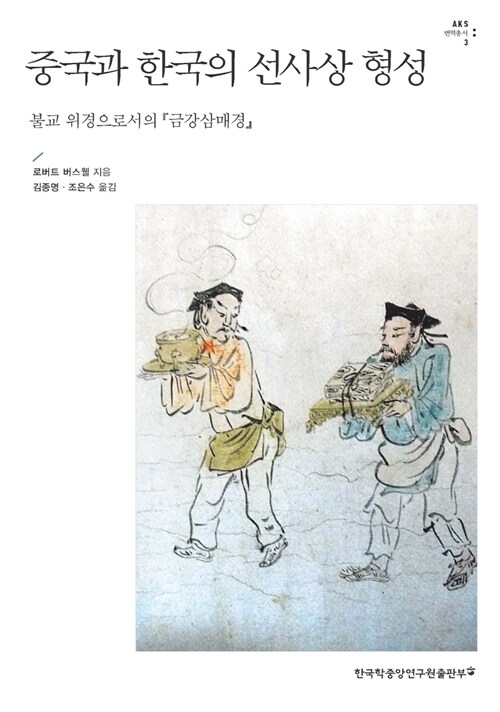
295쪽152*223mm (A5신)413gISBN : 9791158660734
주제 분류
신간알림 신청
국내도서 > 종교/역학 > 불교 > 불교사/불교철학
시리즈AKS 번역총서 (총 12권 모두보기)
신간알림 신청
전체선택
보관함 담기
장바구니 담기
영국 외교관의 근대 한국 탐방
당으로 간 고구려.백제인 - 시안.뤄양 출토 묘지명을 중심으로
역사민속 조선만담 - 근대 일본인 역사민속학자의 조선 민속 고찰기
심리학의 도 - 동시성과 자기(self)
한국전쟁 연구의 새로운 접근
더보기
이벤트
이 시간, 알라딘 굿즈 총집합!
책소개기존의 한국 불교를 중국 불교의 아류로 간주해온 서구학계에서 한국 불교학을 독립적인 학문 분야로 정립시키는데 지대한 공헌을 한 책이다. 특히 당대 중국과 일본 등 동아시아 불교계 전반에 한국 불교가 미친 영향을 <금강삼매경>을 통해 치밀하게 살펴보고 있다. <금강삼매경>은 중국의 초기 선불교 형성에 미친 한국의 영향을 살필 수 있는 좋은 자료일 뿐만 아니라, 이를 통해 구산선문을 비롯한 한국 초기 선불교에 대한 구체적인 이해도 도모할 수 있다.
목차
저자 서문
한글 번역본에 대한 저자 서문
역자 서문
제1장 「금강삼매경」 위경 연구
1. 「금강삼매경」의 연구: 문제점과 전망
2. 「금강삼매경」의 통합적 경향
3. 「금강삼매경」의 서술구조에 대한 범형
4. 중국의 경전목록 속에 나타난 「금강삼매경」
제2장 원효전: 「금강삼매경」의 연대결정과 기원
1. 「송고승전」과 「금강삼매경」의 기원
2. 「삼국유사」의 고승전과 「금강삼매경」의 찬술연대 결정
3. 원효의 중국행 시도와 깨달음의 경험
4. 주석가와 포교가로서의 원효
제3장 「금강삼매경」의 교학적 이론
1. 동아시아에서의 불교변용
2. 여래장과 깨달음의 내재성
3. 아말라식과 마음의 본래 청정함
4. ‘금강삼매’의 의미: 본유적 깨달음이 갖는 실천적 함축
5. 신라의 불교도에게 주는 「금강삼매경」의 메시지
제4장 「금강삼매경」의 선요소: 이 경의 저자확인을 위한 증거
1. 「금강삼매경」에 미친 선의 영향
2. 초기 선과 법랑의 전설
3. 저자문제
4. 「금강삼매경」의 유산
5. 선불교계에서의 「금강삼매경」의 위치
참고문헌
찾아보기
접기
저자 및 역자소개
로버트 버스웰 (Robert E. Buswell, Jr) (지은이)
저자파일
최고의 작품 투표
신간알림 신청
미국 캘리포니아대학교 버클리캠퍼스(UC Berkeley)를 졸업하고 같은 대학교 대학원에서 불교학으로 박사학위를 받았다. 캘리포니아대학교 로스앤젤레스캠퍼스(UCLA) 특훈교수(distinguished professor), 어빙 앤드 진 스톤 인문학 석좌교수, 불교학연구소 창립 소장으로 재직 중이다. UCLA 한국학연구소 창립 소장, 아시아학회(AAS) 회장, 동국대학교 초대 불교학술원장 등을 역임하였고, 만해 대상(학술부문)을 수상하였다. The Korean Approach to Zen: The Collected Works of Chinul(Honolulu, 1983), The Formation of Ch’an Ideology in China and Korea(Princeton, 1989), Tracing Back the Radiance: Chinul’s Korean Way of Zen(Honolulu, 1991), The Zen Monastic Experience: Buddhist Practice in Contemporary Korea(Princeton, 1992), Cultivating Original Enlightenment: W?nhyo’s Exposition of the Vajrasam?dhi-S?tra(Honolulu, 2007) 등의 저서와 Religions of Korea in Practice(Princeton, 2007), Currents and Counter currents: Korean Influences on the East Asian Buddhist Traditions(Honolulu, 2005) 등의 편저가 있다. 대표적 불교사전인 Encyclopedia of Buddhism(Macmillan Reference, 2004), The Princeton Dictionary of Buddhism(Princeton University Press, 2013) 등을 편찬하였다. 접기
최근작 : <중국과 한국의 선사상 형성>,<동아시아 속 한국 불교사상가>,<파란 눈 스님의 한국 선 수행기> … 총 6종 (모두보기)
김종명 (옮긴이)
저자파일
최고의 작품 투표
신간알림 신청
서울대학교에서 유가공학 전공으로 학사학위와 석사학위를 받았다. 연세대학교에서 한국학으로 석사과정을 수료한 후, 미국 UCLA에서 한국학·불교학 전공으로 석사·박사학위를 받았다. 불교의례를 포함한 불교문화, 불교와 국가, 선사상 중심의 한국 불교학과 해외 한국학을 연구해오고 있다. 한국학중앙연구원 한국학대학원 교수, 한국연구재단 학술지평가위원, 동아시아불교문화학회 부회장으로 재직 중이다. 한국학중앙연구원 해외한국학연구소 창립소장직, 고전학연구소 소장직을 역임하고 청호불교복지대상(학술 부문), 불이상(학술 부문)을 수상했으며, Marq... 더보기
최근작 : <상원연등회와 중동팔관회>,<국왕의 불교관과 치국책>,<종교 근본주의> … 총 17종 (모두보기)
조은수 (옮긴이)
저자파일
최고의 작품 투표
신간알림 신청
샤카디타 코리아 공동대표, 서울대학교 철학과 교수. 서울대학교 규장각 국제한국학센터 초대 소장, 유네스코 아시아태평양지역 세계기록문화유산 출판소위원회 의장, 서울대학교 철학사상연구소 소장을 역임하였고, 2013~2015년 불교학연구회 회장을 지냈다.
최근작 : <불교 페미니즘과 리더십>,<마음과 철학 : 불교편>,<한국의 고전을 읽는다 5> … 총 5종 (모두보기)
출판사 제공
책소개
이 책은 현재 불교학의 세계적 권위자인 로버트 버스웰(Robert E. Buswell Jr.)이 1985년 캘리포니아주립대학교 버클리캠퍼스에 제출한 박사학위 논문을 원본으로, 1989년 프린스턴대학교출판부에서 출판한 책을 김종명 한국학중앙연구원 교수와 조은수 서울대학교 교수가 공동으로 번역한 책이다.
「중국과 한국의 선사상 형성」은 기존의 한국 불교를 중국 불교의 아류로 간주해온 서구학계에서 한국 불교학을 독립적인 학문 분야로 정립시키는데 지대한 공헌을 한 책이다. 특히 당대 중국과 일본 등 동아시아 불교계 전반에 한국 불교가 미친 영향을 「금강삼매경」을 통해 치밀하게 살펴보고 있다. 「금강삼매경」은 중국의 초기 선불교 형성에 미친 한국의 영향을 살필 수 있는 좋은 자료일 뿐만 아니라, 이를 통해 구산선문을 비롯한 한국 초기 선불교에 대한 구체적인 이해도 도모할 수 있다.
중국과 한국의 선사상 형성 - 불교 위경으로서의 「금강삼매경」 | AKS 번역총서 3
로버트 버스웰 (지은이),김종명,조은수 (옮긴이)한국학중앙연구원(한국정신문화연구원)2015-12-30원제 : The Formation of Ch'an Ideology in China and Korea: The Vajrasamadhi-Sutra, A Buddhist Apocryphon

295쪽152*223mm (A5신)413gISBN : 9791158660734
주제 분류
신간알림 신청
국내도서 > 종교/역학 > 불교 > 불교사/불교철학
시리즈AKS 번역총서 (총 12권 모두보기)
신간알림 신청
전체선택
보관함 담기
장바구니 담기
영국 외교관의 근대 한국 탐방
당으로 간 고구려.백제인 - 시안.뤄양 출토 묘지명을 중심으로
역사민속 조선만담 - 근대 일본인 역사민속학자의 조선 민속 고찰기
심리학의 도 - 동시성과 자기(self)
한국전쟁 연구의 새로운 접근
더보기
이벤트
이 시간, 알라딘 굿즈 총집합!
책소개기존의 한국 불교를 중국 불교의 아류로 간주해온 서구학계에서 한국 불교학을 독립적인 학문 분야로 정립시키는데 지대한 공헌을 한 책이다. 특히 당대 중국과 일본 등 동아시아 불교계 전반에 한국 불교가 미친 영향을 <금강삼매경>을 통해 치밀하게 살펴보고 있다. <금강삼매경>은 중국의 초기 선불교 형성에 미친 한국의 영향을 살필 수 있는 좋은 자료일 뿐만 아니라, 이를 통해 구산선문을 비롯한 한국 초기 선불교에 대한 구체적인 이해도 도모할 수 있다.
목차
저자 서문
한글 번역본에 대한 저자 서문
역자 서문
제1장 「금강삼매경」 위경 연구
1. 「금강삼매경」의 연구: 문제점과 전망
2. 「금강삼매경」의 통합적 경향
3. 「금강삼매경」의 서술구조에 대한 범형
4. 중국의 경전목록 속에 나타난 「금강삼매경」
제2장 원효전: 「금강삼매경」의 연대결정과 기원
1. 「송고승전」과 「금강삼매경」의 기원
2. 「삼국유사」의 고승전과 「금강삼매경」의 찬술연대 결정
3. 원효의 중국행 시도와 깨달음의 경험
4. 주석가와 포교가로서의 원효
제3장 「금강삼매경」의 교학적 이론
1. 동아시아에서의 불교변용
2. 여래장과 깨달음의 내재성
3. 아말라식과 마음의 본래 청정함
4. ‘금강삼매’의 의미: 본유적 깨달음이 갖는 실천적 함축
5. 신라의 불교도에게 주는 「금강삼매경」의 메시지
제4장 「금강삼매경」의 선요소: 이 경의 저자확인을 위한 증거
1. 「금강삼매경」에 미친 선의 영향
2. 초기 선과 법랑의 전설
3. 저자문제
4. 「금강삼매경」의 유산
5. 선불교계에서의 「금강삼매경」의 위치
참고문헌
찾아보기
접기
저자 및 역자소개
로버트 버스웰 (Robert E. Buswell, Jr) (지은이)
저자파일
최고의 작품 투표
신간알림 신청
미국 캘리포니아대학교 버클리캠퍼스(UC Berkeley)를 졸업하고 같은 대학교 대학원에서 불교학으로 박사학위를 받았다. 캘리포니아대학교 로스앤젤레스캠퍼스(UCLA) 특훈교수(distinguished professor), 어빙 앤드 진 스톤 인문학 석좌교수, 불교학연구소 창립 소장으로 재직 중이다. UCLA 한국학연구소 창립 소장, 아시아학회(AAS) 회장, 동국대학교 초대 불교학술원장 등을 역임하였고, 만해 대상(학술부문)을 수상하였다. The Korean Approach to Zen: The Collected Works of Chinul(Honolulu, 1983), The Formation of Ch’an Ideology in China and Korea(Princeton, 1989), Tracing Back the Radiance: Chinul’s Korean Way of Zen(Honolulu, 1991), The Zen Monastic Experience: Buddhist Practice in Contemporary Korea(Princeton, 1992), Cultivating Original Enlightenment: W?nhyo’s Exposition of the Vajrasam?dhi-S?tra(Honolulu, 2007) 등의 저서와 Religions of Korea in Practice(Princeton, 2007), Currents and Counter currents: Korean Influences on the East Asian Buddhist Traditions(Honolulu, 2005) 등의 편저가 있다. 대표적 불교사전인 Encyclopedia of Buddhism(Macmillan Reference, 2004), The Princeton Dictionary of Buddhism(Princeton University Press, 2013) 등을 편찬하였다. 접기
최근작 : <중국과 한국의 선사상 형성>,<동아시아 속 한국 불교사상가>,<파란 눈 스님의 한국 선 수행기> … 총 6종 (모두보기)
김종명 (옮긴이)
저자파일
최고의 작품 투표
신간알림 신청
서울대학교에서 유가공학 전공으로 학사학위와 석사학위를 받았다. 연세대학교에서 한국학으로 석사과정을 수료한 후, 미국 UCLA에서 한국학·불교학 전공으로 석사·박사학위를 받았다. 불교의례를 포함한 불교문화, 불교와 국가, 선사상 중심의 한국 불교학과 해외 한국학을 연구해오고 있다. 한국학중앙연구원 한국학대학원 교수, 한국연구재단 학술지평가위원, 동아시아불교문화학회 부회장으로 재직 중이다. 한국학중앙연구원 해외한국학연구소 창립소장직, 고전학연구소 소장직을 역임하고 청호불교복지대상(학술 부문), 불이상(학술 부문)을 수상했으며, Marq... 더보기
최근작 : <상원연등회와 중동팔관회>,<국왕의 불교관과 치국책>,<종교 근본주의> … 총 17종 (모두보기)
조은수 (옮긴이)
저자파일
최고의 작품 투표
신간알림 신청
샤카디타 코리아 공동대표, 서울대학교 철학과 교수. 서울대학교 규장각 국제한국학센터 초대 소장, 유네스코 아시아태평양지역 세계기록문화유산 출판소위원회 의장, 서울대학교 철학사상연구소 소장을 역임하였고, 2013~2015년 불교학연구회 회장을 지냈다.
최근작 : <불교 페미니즘과 리더십>,<마음과 철학 : 불교편>,<한국의 고전을 읽는다 5> … 총 5종 (모두보기)
출판사 제공
책소개
이 책은 현재 불교학의 세계적 권위자인 로버트 버스웰(Robert E. Buswell Jr.)이 1985년 캘리포니아주립대학교 버클리캠퍼스에 제출한 박사학위 논문을 원본으로, 1989년 프린스턴대학교출판부에서 출판한 책을 김종명 한국학중앙연구원 교수와 조은수 서울대학교 교수가 공동으로 번역한 책이다.
「중국과 한국의 선사상 형성」은 기존의 한국 불교를 중국 불교의 아류로 간주해온 서구학계에서 한국 불교학을 독립적인 학문 분야로 정립시키는데 지대한 공헌을 한 책이다. 특히 당대 중국과 일본 등 동아시아 불교계 전반에 한국 불교가 미친 영향을 「금강삼매경」을 통해 치밀하게 살펴보고 있다. 「금강삼매경」은 중국의 초기 선불교 형성에 미친 한국의 영향을 살필 수 있는 좋은 자료일 뿐만 아니라, 이를 통해 구산선문을 비롯한 한국 초기 선불교에 대한 구체적인 이해도 도모할 수 있다.
Labels:
Robert E. Buswell,
깨달음,
원효
알라딘: 파란 눈 스님의 한국 선 수행기 로버트 버스웰 The Zen Monastic Experience : Buddhist Practice in Contemporary Korea
알라딘: 파란 눈 스님의 한국 선 수행기
파란 눈 스님의 한국 선 수행기 - 카르마총서 2
로버트 버스웰 (지은이),김종명 (옮긴이)
파란 눈 스님의 한국 선 수행기 - 카르마총서 2
로버트 버스웰 (지은이),김종명 (옮긴이)
예문서원1999-04-15
원제 : The Zen Monastic Experience : Buddhist Practice in Contemporary Korea
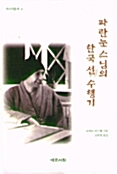
파란 눈 스님의 한국 선 수행기
- 절판 확인일 : 2018-01-17
책소개

파란 눈 스님의 한국 선 수행기
- 절판 확인일 : 2018-01-17
책소개
로스엔젤레스에 있는 캘리포니아대학 교수인 저자가 1974년부터 5년간 송광사에서의 선승 생활을 통해 체험하고 느낀 한국불교에 대한 종합 보고서. 저자는 이 때 경험한 승가 생활을 바탕으로 한국 절의 제도적 구조, 절에서의 일상 생활, 수행 형태, 행자와 이판승 및 사판승들의 활동, 특히 선승들의 활동을 상세히 적고 있다.
김장 만들기, 메주 만들기, 과일따기 등 절에서의 식생활 해결 방법에 관한 부분과 선방의 일과표, 선방 예절, 선방 규정, 여러 고행법 등 선방 생활은 물론이고, 이러한 생활을 견디지 못해 절에서 탈출하는 승려의 이야기까지 자세히 적고 있다.
지은이는 불교 교학에 대한 연구도 중요하지만, 그것을 넘어 교학적 가르침이 실제로 현장에서 어떻게 수행되고 있는가 하는 문제가 더욱 중요하다고 말한다. 이 글을 쓴 목적도 실제로 선승들이 매일 무엇을 하며, 어떻게 실천적 종교 생활을 하고 있는가를 정확하게 전달하는 데 있다고 한다.
또한 구산 스님의 수행기와 그분이 열반에 들 때의 상황 등 구산 스님에 대한 이야기로 많은 지면을 할애하고 있어 지은이의 구산 스님에 대한 각별한 애정과 존경심을 느낄 수 있다.
목차
들어가는 말- 참선 생활과 믿음의 내용
이 책을 쓴 개인적 동기/ 절 생활과 깨달음의 내용/ 참선 이해의 현대적 가치/ 절 전통 연구의 한계/ 승려들의 유형/ 이 책의 기원
1. 한국의 현대 불교
한국의 초기 불교/ 비구승과 대처승의 갈등/ 광복 후의 개혁
2. 일정 계획과 연중 계획
예불/ 연중 계획/ 불교 행사/ 석가탄신일/ 설날 행사
3. 송광사와 구산스님
한국 절의 배치/ 송광사의 역사/ 구산 스님의 삶
4. 승려 생활의 첫 단계
출가 동기/ 행자/ 수계식/ 횐속/ 수계 후의 생활- 예불과 공부/ 운수행각/ 승복
5. 사판직
주지/ 행정승/ 후원의 승려들/ 공양/ 일꾼들/ 대중울력/ 들일/ 김장철/ 메주 만들기/ 과일 따기/ 별식/ 산불/ 건축 공사
6. 세속과의 관계
재가불자회의 초기 모델/ 불일회/ 현대 재가불자회의 모델/ 재가불자회의 장점
7. 한국의 참선 수행
화두 참구/ 현대의 참선 수행
8. 선방 수행
한국 불교 수행상 선방의 위치/ 현대 선방의 일과표/ 선방 입실/ 선방 묘사/ 선방 예절/ 선방 규정/ 잠/ 질병과 보약/ 목욕일/ 절에서의 탈출/ 격주법문/ 용맹정진/ 고행/ 생식/ 단식/ 장좌불와/ 묵언/ 연지/ 분신/ 기타 고행법/ 장기 안거/ 안거 끝
9. 선방의 직책승들
선원의 직책승/ 유나/ 입승과 청중/ 선방의 기타 직책승
=====
저자 및 역자소개
로버트 버스웰 (Robert E. Buswell, Jr) (지은이)
미국 캘리포니아대학교 버클리캠퍼스(UC Berkeley)를 졸업하고 같은 대학교 대학원에서 불교학으로 박사학위를 받았다. 캘리포니아대학교 로스앤젤레스캠퍼스(UCLA) 특훈교수(distinguished professor), 어빙 앤드 진 스톤 인문학 석좌교수, 불교학연구소 창립 소장으로 재직 중이다. UCLA 한국학연구소 창립 소장, 아시아학회(AAS) 회장, 동국대학교 초대 불교학술원장 등을 역임하였고, 만해 대상(학술부문)을 수상하였다.
김장 만들기, 메주 만들기, 과일따기 등 절에서의 식생활 해결 방법에 관한 부분과 선방의 일과표, 선방 예절, 선방 규정, 여러 고행법 등 선방 생활은 물론이고, 이러한 생활을 견디지 못해 절에서 탈출하는 승려의 이야기까지 자세히 적고 있다.
지은이는 불교 교학에 대한 연구도 중요하지만, 그것을 넘어 교학적 가르침이 실제로 현장에서 어떻게 수행되고 있는가 하는 문제가 더욱 중요하다고 말한다. 이 글을 쓴 목적도 실제로 선승들이 매일 무엇을 하며, 어떻게 실천적 종교 생활을 하고 있는가를 정확하게 전달하는 데 있다고 한다.
또한 구산 스님의 수행기와 그분이 열반에 들 때의 상황 등 구산 스님에 대한 이야기로 많은 지면을 할애하고 있어 지은이의 구산 스님에 대한 각별한 애정과 존경심을 느낄 수 있다.
목차
들어가는 말- 참선 생활과 믿음의 내용
이 책을 쓴 개인적 동기/ 절 생활과 깨달음의 내용/ 참선 이해의 현대적 가치/ 절 전통 연구의 한계/ 승려들의 유형/ 이 책의 기원
1. 한국의 현대 불교
한국의 초기 불교/ 비구승과 대처승의 갈등/ 광복 후의 개혁
2. 일정 계획과 연중 계획
예불/ 연중 계획/ 불교 행사/ 석가탄신일/ 설날 행사
3. 송광사와 구산스님
한국 절의 배치/ 송광사의 역사/ 구산 스님의 삶
4. 승려 생활의 첫 단계
출가 동기/ 행자/ 수계식/ 횐속/ 수계 후의 생활- 예불과 공부/ 운수행각/ 승복
5. 사판직
주지/ 행정승/ 후원의 승려들/ 공양/ 일꾼들/ 대중울력/ 들일/ 김장철/ 메주 만들기/ 과일 따기/ 별식/ 산불/ 건축 공사
6. 세속과의 관계
재가불자회의 초기 모델/ 불일회/ 현대 재가불자회의 모델/ 재가불자회의 장점
7. 한국의 참선 수행
화두 참구/ 현대의 참선 수행
8. 선방 수행
한국 불교 수행상 선방의 위치/ 현대 선방의 일과표/ 선방 입실/ 선방 묘사/ 선방 예절/ 선방 규정/ 잠/ 질병과 보약/ 목욕일/ 절에서의 탈출/ 격주법문/ 용맹정진/ 고행/ 생식/ 단식/ 장좌불와/ 묵언/ 연지/ 분신/ 기타 고행법/ 장기 안거/ 안거 끝
9. 선방의 직책승들
선원의 직책승/ 유나/ 입승과 청중/ 선방의 기타 직책승
=====
저자 및 역자소개
로버트 버스웰 (Robert E. Buswell, Jr) (지은이)
미국 캘리포니아대학교 버클리캠퍼스(UC Berkeley)를 졸업하고 같은 대학교 대학원에서 불교학으로 박사학위를 받았다. 캘리포니아대학교 로스앤젤레스캠퍼스(UCLA) 특훈교수(distinguished professor), 어빙 앤드 진 스톤 인문학 석좌교수, 불교학연구소 창립 소장으로 재직 중이다. UCLA 한국학연구소 창립 소장, 아시아학회(AAS) 회장, 동국대학교 초대 불교학술원장 등을 역임하였고, 만해 대상(학술부문)을 수상하였다.
The Korean Approach to Zen: The Collected Works of Chinul(Honolulu, 1983), The Formation of Ch’an Ideology in China and Korea(Princeton, 1989), Tracing Back the Radiance: Chinul’s Korean Way of Zen(Honolulu, 1991), The Zen Monastic Experience: Buddhist Practice in Contemporary Korea(Princeton, 1992), Cultivating Original Enlightenment: W?nhyo’s Exposition of the Vajrasam?dhi-S?tra(Honolulu, 2007) 등의 저서와 Religions of Korea in Practice(Princeton, 2007), Currents and Counter currents: Korean Influences on the East Asian Buddhist Traditions(Honolulu, 2005) 등의 편저가 있다. 대표적 불교사전인 Encyclopedia of Buddhism(Macmillan Reference, 2004), The Princeton Dictionary of Buddhism(Princeton University Press, 2013) 등을 편찬하였다. 접기
최근작 : <중국과 한국의 선사상 형성>,<동아시아 속 한국 불교사상가>,<파란 눈 스님의 한국 선 수행기> … 총 6종 (모두보기)
김종명 (옮긴이)
서울대학교에서 유가공학 전공으로 학사학위와 석사학위를 받았다. 연세대학교에서 한국학으로 석사과정을 수료한 후, 미국 UCLA에서 한국학·불교학 전공으로 석사·박사학위를 받았다. 불교의례를 포함한 불교문화, 불교와 국가, 선사상 중심의 한국 불교학과 해외 한국학을 연구해오고 있다. 한국학중앙연구원 한국학대학원 교수, 한국연구재단 학술지평가위원, 동아시아불교문화학회 부회장으로 재직 중이다. 한국학중앙연구원 해외한국학연구소 창립소장직, 고전학연구소 소장직을 역임하고 청호불교복지대상(학술 부문), 불이상(학술 부문)을 수상했으며, Marquis Who’s Who in the World에 수차례 등재되었다.
최근작 : <중국과 한국의 선사상 형성>,<동아시아 속 한국 불교사상가>,<파란 눈 스님의 한국 선 수행기> … 총 6종 (모두보기)
김종명 (옮긴이)
서울대학교에서 유가공학 전공으로 학사학위와 석사학위를 받았다. 연세대학교에서 한국학으로 석사과정을 수료한 후, 미국 UCLA에서 한국학·불교학 전공으로 석사·박사학위를 받았다. 불교의례를 포함한 불교문화, 불교와 국가, 선사상 중심의 한국 불교학과 해외 한국학을 연구해오고 있다. 한국학중앙연구원 한국학대학원 교수, 한국연구재단 학술지평가위원, 동아시아불교문화학회 부회장으로 재직 중이다. 한국학중앙연구원 해외한국학연구소 창립소장직, 고전학연구소 소장직을 역임하고 청호불교복지대상(학술 부문), 불이상(학술 부문)을 수상했으며, Marquis Who’s Who in the World에 수차례 등재되었다.
저서로 『국왕의 불교관과 치국책』(한국학술정보, 2013), 『한국의 세계불교유산』(집문당, 2008), 『한국 중세의 불교의례』(문학과지성사, 2001), Korean Religions in Relation(공저, SUNY Press, 2016), Zen Buddhist Rhetoric in China, Korea, and Japan(공저, Brill, 2012), Makers of Modern Korean Buddhism(공저, SUNY Press, 2010), Buddhism: Introducing the Buddhist Experience(공저, Oxford University Press, 2008), Traditions and Traditional Theories(공저, LIT Verlag, 2006), Korea and Globalization(공저, RoutledgeCurzon, 2002) 등이 있고, Korean Studies, Korea Journal을 비롯한 다수의 국내외 학술지에 논문을 게재했다. 역서로는 『북종과 초기 선불교의 형성』(민족사, 2018), 『중국과 한국의 선사상 형성』(한국학중앙연구원출판부, 2015), 『파란 눈 스님의 한국선 수행기』(예문서원, 1999)가 있다. 접기
최근작 : <상원연등회와 중동팔관회>,<국왕의 불교관과 치국책>,<종교 근본주의> … 총 17종 (모두보기)
마이리뷰
외국인이 본 한국불교의 전통과 실제
얼마 전에 현각이란 법명을 쓰시는 폴 뮌젠 스님의 불교입문기가 베스트셀러가 되면서 불교에 대한 대중적 관심이 고조된 바가 있었다. 이 책은 원래 1992년 미국에서 출판된 책으로 한국 불교를 1970년대에 직접 체험했던 저자의 기록으로 현각의 이야기보다는 좀 더 객관적이고 세밀하다. 현각 스님의 책은 자신의 종교적 회심이란 사적인 면에 더 치중하고 있으니까... 그리고 숭산이란 자신의 스승을 한껏 치켜올리는데 열중하고 있으니까... 반면 저자 로버트 버스웰은 송광사 구산스님 밑에서 수행생활을 했지만 그와의 인연이 그리 큰 부분을 차지하지는 않는다.
그보다는 한국 불교의 특성과 전통, 그리고 실제적인 수행과 삶의 내용을 세밀하게 담고 있다. 현각의 책이 에세이 풍이라면 이 책은 설명문에 가깝고 선가의 관습과 직책, 수행의 구체적인 방법론들과 그 과정에서의 실제적인 일화들, 승려생활들의 요모조모등을 시시콜콜하게 담고 있다. 수행기라기 보다는 인류학적 보고서에 더 가까운 듯 하다.
간달프 2001-09-03 공감(3) 댓글(0)
Thanks to
공감
---------------

The Zen Monastic Experience: Buddhist Practice in Contemporary Korea Paperback – 15 December 1993
by Robert E Buswell (Author)
4.4 out of 5 stars 6 ratings
Robert Buswell, a Buddhist scholar who spent five years as a Zen monk in Korea, draws on personal experience in this insightful account of day-to-day Zen monastic practice. In discussing the activities of the postulants, the meditation monks, the teachers and administrators, and the support monks of the monastery of Songgwang-sa, Buswell reveals a religious tradition that differs radically from the stereotype prevalent in the West. The author's treatment lucidly relates contemporary Zen practice to the historical development of the tradition and to Korean history more generally, and his portrayal of the life of modern Zen monks in Korea provides an innovative and provocative look at Zen from the inside.
Paperback: 288 pages
Publisher: Princeton University Press; 1 edition (15 December 1993)
Customer Reviews: 4.4 out of 5 stars6 customer ratings
Product description
Review
A myth-shattering foray behind the walls of a Korean Zen Buddhist monastery.... Less the sound of one hand clapping than of hands, mind and heart working together to lead a sanctified life--and, as such, a sound corrective to Western misunderstandings about Zen.Kirkus Reviews is ... forged from own experience and practice.... He enlivens his study with a detailed personal account of his daily life at Songgwang-sa, one of Korea's main monasteries, and with wry humor.... This book should be read by anyone interested in the daily life of Zen training.Martine BatchelorTricycle: The Buddhist Review
From the Back Cover
Robert Buswell, a Buddhist scholar who spent five years as a Zen monk in Korea, draws on personal experience in this insightful account of day-to-day Zen monastic practice. Buswell's depiction of Zen reveals a religious tradition that differs radically from the stereotype prevalent in the West. Westerners exposed to Zen through English-language materials have been offered a picture of an iconoclastic religion that is bibliophobic, institutionally subversive, aesthetically sophisticated, devoted to manual labor, and intent solely on sudden enlightenment. Its most revered teachers are depicted as torching their sacred religious icons, bullying their students into enlightenment, rejecting the value of all the scriptures of Buddhism, and even denying the worth of Zen itself. In discussing the activities of the postulants, the meditation monks, the teachers and administrators, and the support monks of Song-gwang-sa, a major Korean Buddhist monastery, Buswell challenges much of this picture. In the "counterparadigm" of Zen offered in the daily lives of the monks, Zen's putative iconoclasts are replaced by resolute members of a community dedicated to a methodical regimen of spiritual training. Zen's apparent bibliophobia pales to reveal contemplatives learned in classical Chinese and often having extensive experience in Buddhist seminaries. And the brash challenge allegedly made to systematizations of religion, even to Zen itself, fades before monks with strong faith in the arduous way of life they have undertaken. The author's treatment lucidly relates contemporary Zen practice to the historical development of the tradition and to Korean history more generally, and his intimate, sympatheticportrayal of the life of modern Zen monks in Korea provides an innovative and provocative look at Zen from the inside.
About the Author
Robert E. Buswell, Jr., is Professor of East Asian Languages and Cultures and Director of the Center for Korean Studies at the University of California, Los Angeles. Among his other works is The Formation of Ch'an Ideology in China and Korea (Princeton).
Customer reviews
4.4 out of 5 stars
Top international reviews
M
5.0 out of 5 stars informative
Reviewed in Canada on 21 March 2018
Good book, informative. Recommend reading in the rain or stay well hydrated, its a bit dry.
Lily Penny
5.0 out of 5 stars Wonderful, I loved it
Reviewed in the United States on 20 April 2010
Robert Buswell crafts the book "The Zen Monastic Experience" from a combination of research and personal experience in order to shed light on the monastic life and communities of Korea. He gives historic accounts and research interspersed with anecdotes from his own years spent as a monk in the Korean monastery Songgwang-sa. While this book may at first appear to be a written construct of Buswell's historical and ethnographic research, there is revealed an underlying motive to change contemporary Western views of Zen. Buswell uses Korean Buddhism as an example against typical Western thought on the topic, and states in his conclusion, "Modern Son monastic life in Korea therefore offers a valuable counterparadigm to the usual Western portrayals of Zen, an alternative vision that yields quite a different picture of the day-to-day reality of Zen religious experience from that to which we in the West have become accustomed" (Buswell 223). He spends the book explaining his research on the topic and giving a full view of everything about Korean monastic life. In his conclusion he shows some of the disparities between typical Western thought and the Buddhism he has showed in the preceding pages. He argues for a "reappraisal of Zen religious experience" (Buswell 217).
Buswell's combination of research and personal experience makes this book both profoundly informative and entertaining. For every description he gives of a Son practice or monastic tradition, he has a story to illustrate the point more fully. This makes the book suitable for many audiences; it provides the accurate ethnographic and historical research a scholar would require as well as the interesting personalities that would make the book great for even an everyday reader. For example, when describing the different administrative positions within the monasteries, he gives both detailed information about what the job entails as well as behind-the-scenes looks at the politics surrounding it. After describing the position of Abbot, he mentions that because of the heavy workload involved, the monks often have to "cajole someone into accepting the job" (Buswell 109). Later when talking about the intensive meditation week that is practiced during the winter retreat, he describes the occurrence through his own experience. He provides the reader with insight into not only the details of practice, but the effects it had on the practitioner. He says at the end of his talk about intensive meditation, "Then it really was quite remarkable how effective - even almost refreshing, in a bizarre sort of way - such intensive practice could be" (Buswell 189). It is this mixture of information and experience that makes the book so different and compelling to read.
It is precisely this strength that I believe leads to the major drawback of the work. Because he is mixing together several different sources of information, he ends up jumping from topic to topic with little organization. To be fair, strong organization would certainly be difficult in such a work, but the lack of coherency in places leads to confusion and slight frustration while reading. For example, he places the chapters involving administrative officers of the "Support Division" and involving the "Officers of the Meditation Compound" with several other chapters about relations with the laity, history, and practice in between. It was rather confusing to read because just when you thought you had learned about all of the different positions in the monastery, there was an entire chapter left to go. It also felt out of place to have the chapters about the actual monastic practice come before the listings of the different positions because those positions had already been mentioned several times before, and you almost had to skip ahead to find out more about them. This disorganization, however, was the only drawback to the book; overall I found the work extremely informative and enchanting to read.
2 people found this helpful
--
Kindle Customer
3.0 out of 5 stars It wasn't a bad book, I just didn't enjoy it
Reviewed in the United States on 24 May 2017
Required reading for my history class. It wasn't a bad book, I just didn't enjoy it.
One person found this helpful
--
Juri Christensen
4.0 out of 5 stars Very interest insight into the everyday Zen life
Reviewed in the United States on 4 October 2010
It has been some years since I read this book, bit I still remember it ag giving a very interesting insigth into the Korean monestary life. I would recomend it. Love,
최근작 : <상원연등회와 중동팔관회>,<국왕의 불교관과 치국책>,<종교 근본주의> … 총 17종 (모두보기)
마이리뷰
외국인이 본 한국불교의 전통과 실제
얼마 전에 현각이란 법명을 쓰시는 폴 뮌젠 스님의 불교입문기가 베스트셀러가 되면서 불교에 대한 대중적 관심이 고조된 바가 있었다. 이 책은 원래 1992년 미국에서 출판된 책으로 한국 불교를 1970년대에 직접 체험했던 저자의 기록으로 현각의 이야기보다는 좀 더 객관적이고 세밀하다. 현각 스님의 책은 자신의 종교적 회심이란 사적인 면에 더 치중하고 있으니까... 그리고 숭산이란 자신의 스승을 한껏 치켜올리는데 열중하고 있으니까... 반면 저자 로버트 버스웰은 송광사 구산스님 밑에서 수행생활을 했지만 그와의 인연이 그리 큰 부분을 차지하지는 않는다.
그보다는 한국 불교의 특성과 전통, 그리고 실제적인 수행과 삶의 내용을 세밀하게 담고 있다. 현각의 책이 에세이 풍이라면 이 책은 설명문에 가깝고 선가의 관습과 직책, 수행의 구체적인 방법론들과 그 과정에서의 실제적인 일화들, 승려생활들의 요모조모등을 시시콜콜하게 담고 있다. 수행기라기 보다는 인류학적 보고서에 더 가까운 듯 하다.
간달프 2001-09-03 공감(3) 댓글(0)
Thanks to
공감
---------------

The Zen Monastic Experience: Buddhist Practice in Contemporary Korea Paperback – 15 December 1993
by Robert E Buswell (Author)
4.4 out of 5 stars 6 ratings
Robert Buswell, a Buddhist scholar who spent five years as a Zen monk in Korea, draws on personal experience in this insightful account of day-to-day Zen monastic practice. In discussing the activities of the postulants, the meditation monks, the teachers and administrators, and the support monks of the monastery of Songgwang-sa, Buswell reveals a religious tradition that differs radically from the stereotype prevalent in the West. The author's treatment lucidly relates contemporary Zen practice to the historical development of the tradition and to Korean history more generally, and his portrayal of the life of modern Zen monks in Korea provides an innovative and provocative look at Zen from the inside.
Paperback: 288 pages
Publisher: Princeton University Press; 1 edition (15 December 1993)
Customer Reviews: 4.4 out of 5 stars6 customer ratings
Product description
Review
A myth-shattering foray behind the walls of a Korean Zen Buddhist monastery.... Less the sound of one hand clapping than of hands, mind and heart working together to lead a sanctified life--and, as such, a sound corrective to Western misunderstandings about Zen.Kirkus Reviews is ... forged from own experience and practice.... He enlivens his study with a detailed personal account of his daily life at Songgwang-sa, one of Korea's main monasteries, and with wry humor.... This book should be read by anyone interested in the daily life of Zen training.Martine BatchelorTricycle: The Buddhist Review
From the Back Cover
Robert Buswell, a Buddhist scholar who spent five years as a Zen monk in Korea, draws on personal experience in this insightful account of day-to-day Zen monastic practice. Buswell's depiction of Zen reveals a religious tradition that differs radically from the stereotype prevalent in the West. Westerners exposed to Zen through English-language materials have been offered a picture of an iconoclastic religion that is bibliophobic, institutionally subversive, aesthetically sophisticated, devoted to manual labor, and intent solely on sudden enlightenment. Its most revered teachers are depicted as torching their sacred religious icons, bullying their students into enlightenment, rejecting the value of all the scriptures of Buddhism, and even denying the worth of Zen itself. In discussing the activities of the postulants, the meditation monks, the teachers and administrators, and the support monks of Song-gwang-sa, a major Korean Buddhist monastery, Buswell challenges much of this picture. In the "counterparadigm" of Zen offered in the daily lives of the monks, Zen's putative iconoclasts are replaced by resolute members of a community dedicated to a methodical regimen of spiritual training. Zen's apparent bibliophobia pales to reveal contemplatives learned in classical Chinese and often having extensive experience in Buddhist seminaries. And the brash challenge allegedly made to systematizations of religion, even to Zen itself, fades before monks with strong faith in the arduous way of life they have undertaken. The author's treatment lucidly relates contemporary Zen practice to the historical development of the tradition and to Korean history more generally, and his intimate, sympatheticportrayal of the life of modern Zen monks in Korea provides an innovative and provocative look at Zen from the inside.
About the Author
Robert E. Buswell, Jr., is Professor of East Asian Languages and Cultures and Director of the Center for Korean Studies at the University of California, Los Angeles. Among his other works is The Formation of Ch'an Ideology in China and Korea (Princeton).
Customer reviews
4.4 out of 5 stars
Top international reviews
M
5.0 out of 5 stars informative
Reviewed in Canada on 21 March 2018
Good book, informative. Recommend reading in the rain or stay well hydrated, its a bit dry.
Lily Penny
5.0 out of 5 stars Wonderful, I loved it
Reviewed in the United States on 20 April 2010
Robert Buswell crafts the book "The Zen Monastic Experience" from a combination of research and personal experience in order to shed light on the monastic life and communities of Korea. He gives historic accounts and research interspersed with anecdotes from his own years spent as a monk in the Korean monastery Songgwang-sa. While this book may at first appear to be a written construct of Buswell's historical and ethnographic research, there is revealed an underlying motive to change contemporary Western views of Zen. Buswell uses Korean Buddhism as an example against typical Western thought on the topic, and states in his conclusion, "Modern Son monastic life in Korea therefore offers a valuable counterparadigm to the usual Western portrayals of Zen, an alternative vision that yields quite a different picture of the day-to-day reality of Zen religious experience from that to which we in the West have become accustomed" (Buswell 223). He spends the book explaining his research on the topic and giving a full view of everything about Korean monastic life. In his conclusion he shows some of the disparities between typical Western thought and the Buddhism he has showed in the preceding pages. He argues for a "reappraisal of Zen religious experience" (Buswell 217).
Buswell's combination of research and personal experience makes this book both profoundly informative and entertaining. For every description he gives of a Son practice or monastic tradition, he has a story to illustrate the point more fully. This makes the book suitable for many audiences; it provides the accurate ethnographic and historical research a scholar would require as well as the interesting personalities that would make the book great for even an everyday reader. For example, when describing the different administrative positions within the monasteries, he gives both detailed information about what the job entails as well as behind-the-scenes looks at the politics surrounding it. After describing the position of Abbot, he mentions that because of the heavy workload involved, the monks often have to "cajole someone into accepting the job" (Buswell 109). Later when talking about the intensive meditation week that is practiced during the winter retreat, he describes the occurrence through his own experience. He provides the reader with insight into not only the details of practice, but the effects it had on the practitioner. He says at the end of his talk about intensive meditation, "Then it really was quite remarkable how effective - even almost refreshing, in a bizarre sort of way - such intensive practice could be" (Buswell 189). It is this mixture of information and experience that makes the book so different and compelling to read.
It is precisely this strength that I believe leads to the major drawback of the work. Because he is mixing together several different sources of information, he ends up jumping from topic to topic with little organization. To be fair, strong organization would certainly be difficult in such a work, but the lack of coherency in places leads to confusion and slight frustration while reading. For example, he places the chapters involving administrative officers of the "Support Division" and involving the "Officers of the Meditation Compound" with several other chapters about relations with the laity, history, and practice in between. It was rather confusing to read because just when you thought you had learned about all of the different positions in the monastery, there was an entire chapter left to go. It also felt out of place to have the chapters about the actual monastic practice come before the listings of the different positions because those positions had already been mentioned several times before, and you almost had to skip ahead to find out more about them. This disorganization, however, was the only drawback to the book; overall I found the work extremely informative and enchanting to read.
2 people found this helpful
--
Kindle Customer
3.0 out of 5 stars It wasn't a bad book, I just didn't enjoy it
Reviewed in the United States on 24 May 2017
Required reading for my history class. It wasn't a bad book, I just didn't enjoy it.
One person found this helpful
--
Juri Christensen
4.0 out of 5 stars Very interest insight into the everyday Zen life
Reviewed in the United States on 4 October 2010
It has been some years since I read this book, bit I still remember it ag giving a very interesting insigth into the Korean monestary life. I would recomend it. Love,
rdv
5.0 out of 5 stars Five Stars
Reviewed in the United States on 9 February 2016
Very good and informative; nice reading.
5.0 out of 5 stars Five Stars
Reviewed in the United States on 9 February 2016
Very good and informative; nice reading.
알라딘: 텐진 빠모의 마음공부 Reflection on a Mountain Lake (2002
알라딘: 텐진 빠모의 마음공부
텐진 빠모의 마음공부

텐진 빠모 (지은이),김은령 (옮긴이)열림원2004-07-12원제 : Reflection on a Mountain Lake (2002년)
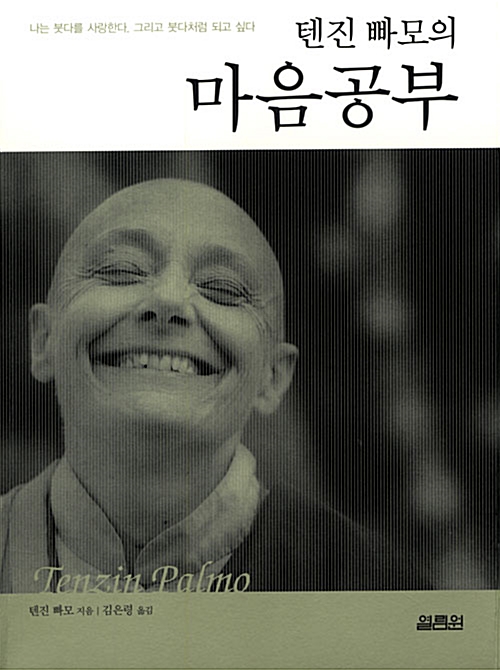



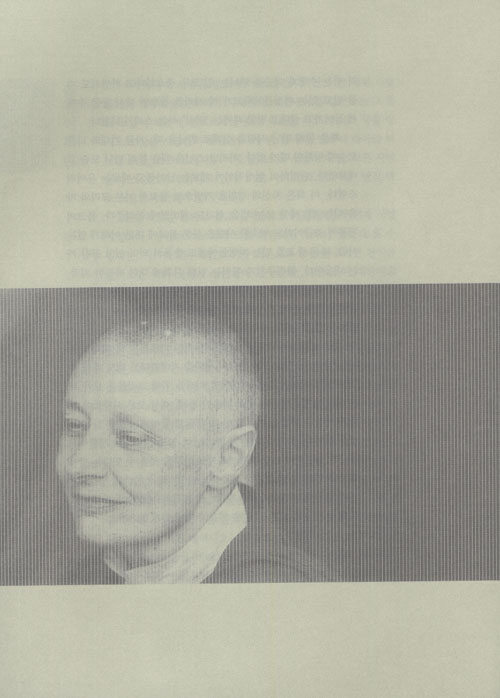


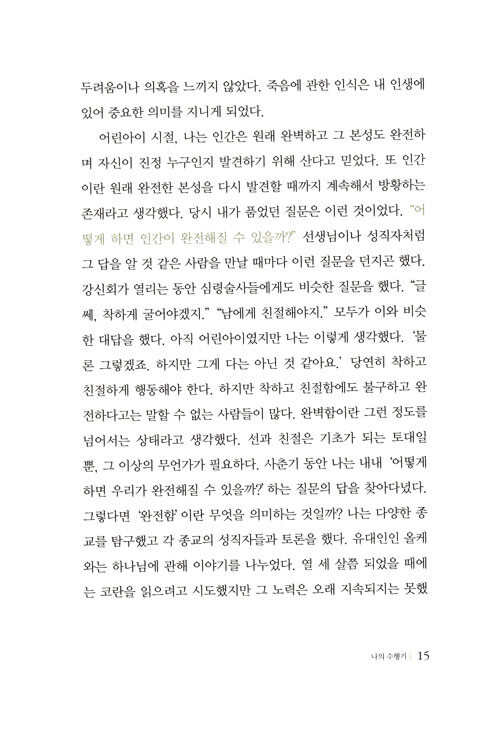
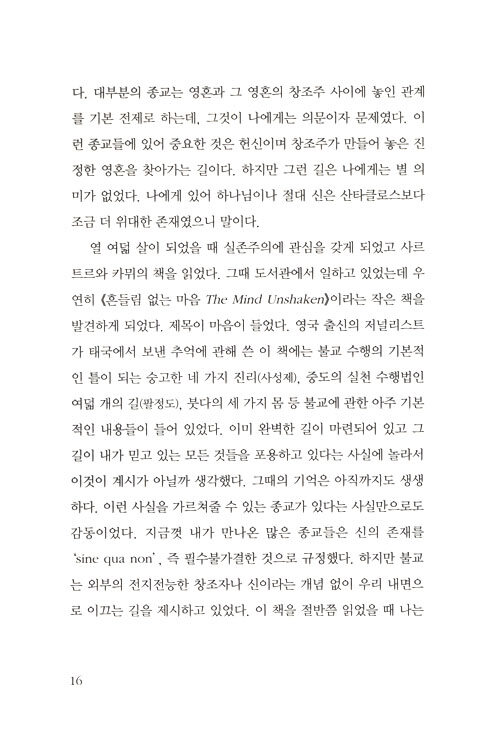

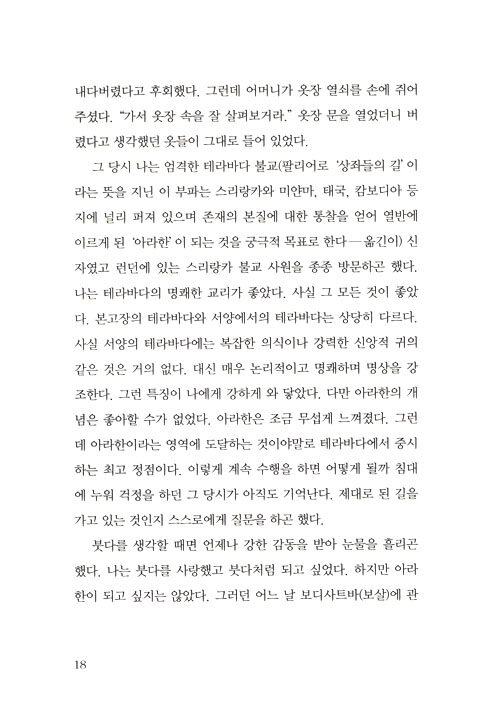

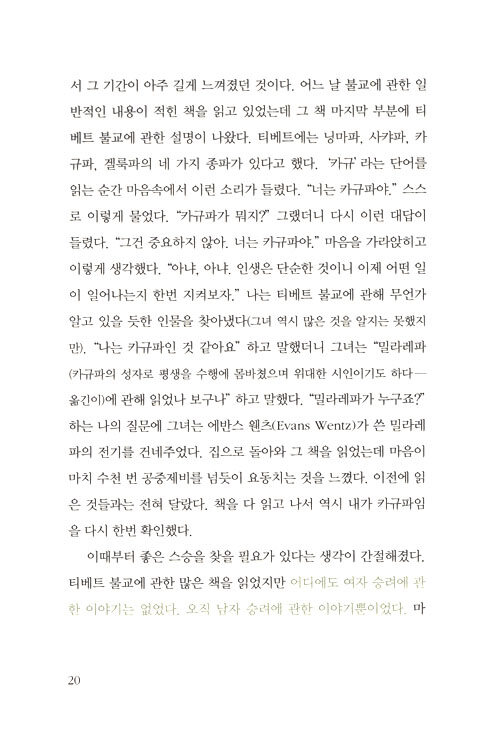
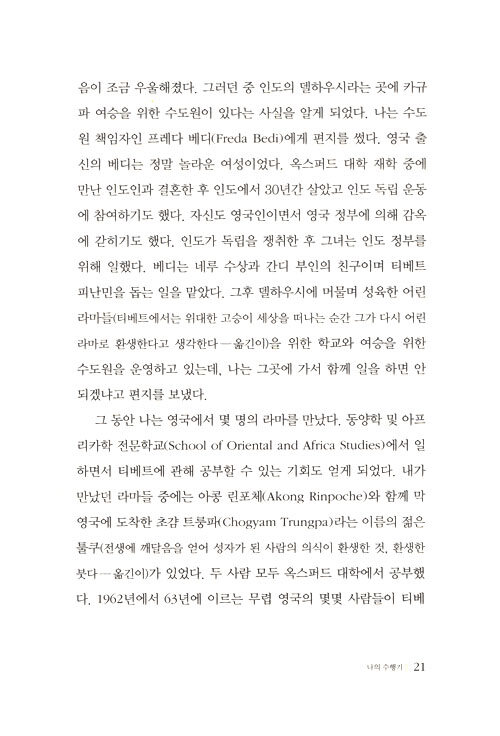

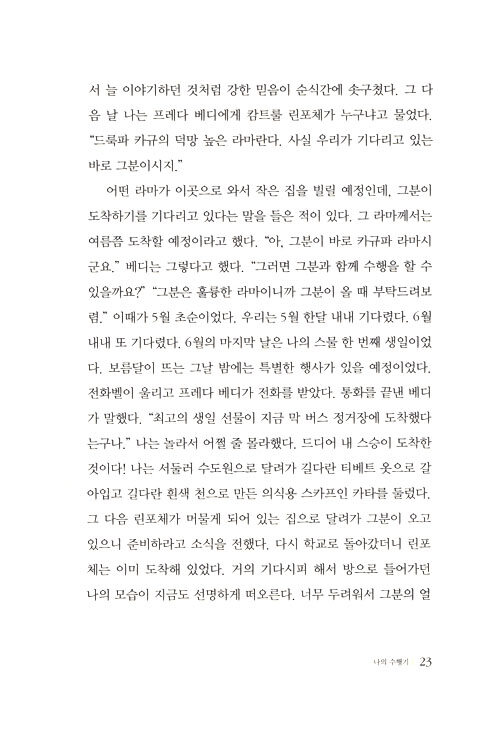



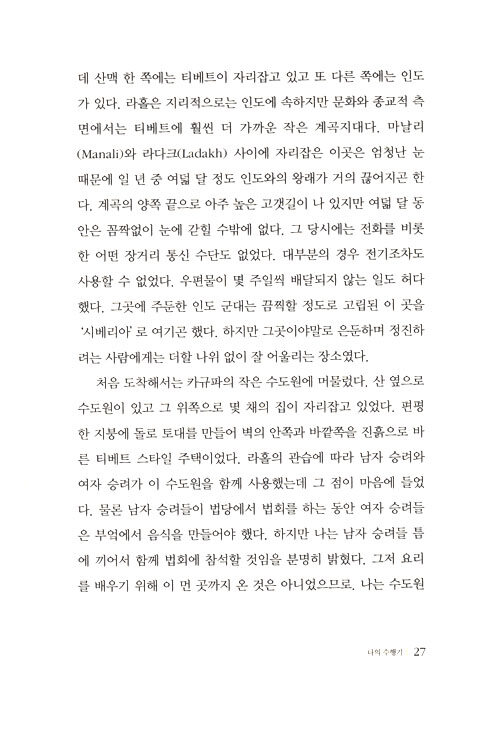

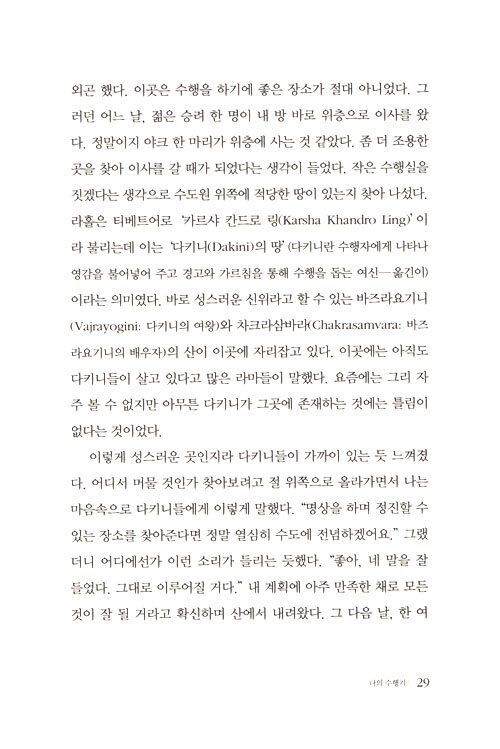
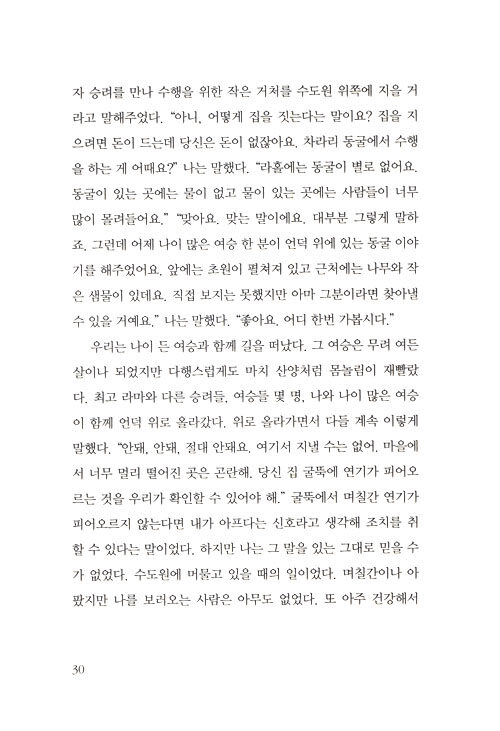
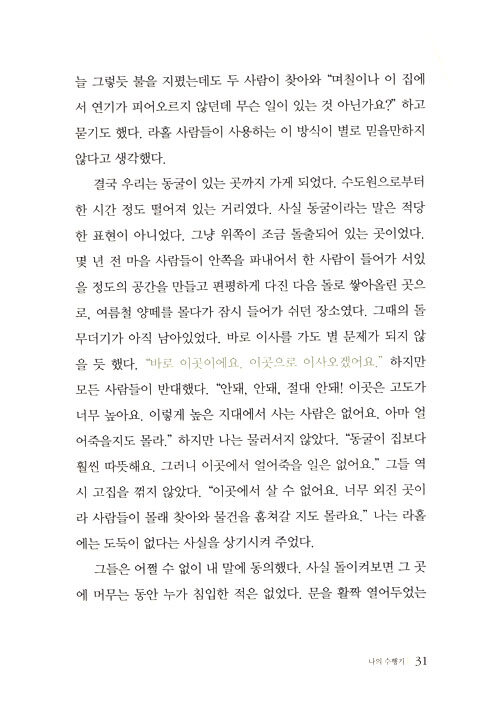
 미리보기
미리보기
새상품 eBook 중고상품 (28)
판매알림 신청 출간알림 신청
출간알림 신청 3,800원
3,800원
384쪽
책소개
20세의 나이에 출가해 서양 여성 최초로 티베트 수도승 계를 받고 이후 인도에서 수행하며 지낸 24년 가운데 12년을 히말라야 동굴에서 홀로 수행한 텐진 빠모 스님. 2003년에 소개된 <나는 여성의 몸으로 붓다가 되리라>를 통해 알려진 텐진 빠모 스님이 불교의 깨달음과 수행법을 쉽게 풀어 소개한다.
1987년부터 1998년까지 미국과 오스트레일리아에서 강연한 내용을 재구성하여 정리했다. 재가 불자들을 만난 자리에서 받은 불교의 원리나 생활 속의 수행에 관해 받은 질문과 그에 대한 스님의 답변을 수록했다.
목차
지은이의 말
옮긴이의 말
1. 나의 수행기
2. 동기와 수행
3. 생활 속의 수행
4. 여섯 가지 윤회
5. 여성과 구도의 길
6. 사마타, 혹은 고요히 머물기
7. 비파사나, 혹은 직관
8. 깨달음
9. 의심, 그리고 환생과 업보
10. 통렌, 주고받음의 수행
11. 마음의 본질
12. 영적 스승의 역할
책속에서
구도의 길은 스스로 경험하는 것이지 다른 사람들이 설명한 것을 답습하는 것이 아니다. 맹목적인 믿음에 기반한 것도 아니다. 물론 필요한 표를 사고 여행을 떠나려면 신념이 필요하다. 방문할 가치가 있는 여행지가 존재한다는 사실을 믿어야만 한다. 하지만 그보다 훨씬 중요한 것은 그저 계속해서 길을 가는 것이다. 길을 떠나면서 스스로 이렇게 말할지도 모른다. '이 길이 바로 사람들이 설명했던 그 길이군, 설명대로인데.'
편지를 쓴다고 해도, 컴퓨터를 사용하고 있다고 해도, 다른 어떤 일을 한다고 해도 지금 하는 일에 온통 집중해야만 한다. 기본적으로 이것이 사마타이다. 마음 한 쪽에서 다른 일을 생각하지 않고 무엇을 하던지 온 마음과 정성을 다하는 것 말이다. 마음을 절반만 쏟는다면 아무리 열심히 한다고 해도 마음속 내적 갈등이 일어나게 된다. -- 본문 중에서 접기
저자 및 역자소개
텐진 빠모 (Vicki Mackenzie) (지은이)
저자파일
샤카디타 인터내셔널 회장. 영국 런던에서 태어나서 1964년 20세 때 정신적인 구도의 길을 찾아 인도로 건너가 티베트 스님 제8대 캄툴 린포체를 만났고, 서양 여성으로서는 최초의 티베트 비구니가 되었다. 12년간 히말라야 동굴에서 은둔 수행한 감동적 이야기가 『Cave in the Snow』라는 제목으로 엮어져 나왔다(한국에서는 『나는 여성의 몸으로 붓다가 되리라』라는 제목으로 번역되었음).
최근작 : <불교 페미니즘과 리더십>,<나는 여성의 몸으로 붓다가 되리라>,<텐진 빠모의 마음공부> … 총 19종 (모두보기)
김은령 (옮긴이)
저자파일
최고의 작품 투표
신간알림 신청
월간 ≪럭셔리≫ 편집장이자 번역가. <바보들은 항상 여자 탓만 한다>, <비즈니스 라이팅>, <럭셔리 이즈> 등을 썼고 <패스트푸드의 제국>, <침묵의 봄>, <나이 드는 것의 미덕>, <존 로빈스의 인생 혁명> 등 20여 권을 번역했다. 이화여자대학교에서 영어영문학을 전공하고 같은 학교 대학원에서 언론학 석사학위를 받았다. ≪행복이 가득한 집≫ 편집장을 지냈으며 <설득의 심리학 워크북>(김호 공역)을 옮겼다.
최근작 : <밥보다 책>,<럭셔리 is>,<비즈 라이팅> … 총 41종 (모두보기)





이런 좋은 책은 재판도 좀 내주고 이북도 좀 만들어주지... 도서관 책 발췌하느라 너무 힘들었다...
yuna 2019-07-05 공감 (1) 댓글 (0)
Thanks to
공감
마이리뷰





[마이리뷰] 텐진 빠모의 마음공부
텐진 빠모의 마음공부, 텐진빠모 저, 김은령 역, 열림원, 2004
오후 4:13 2017-09-29
˝깨끗하고 고매한 마음을 갖기 위해서는 긴장 푸는 법을 배워야 합니다. 긴장한 상태에서 시작한다면 수행을 할수록 더욱 긴장하게 됩니다. 일단 렁(˝결제 수행 중인 사람들에게서 나타난다는 심각한 공황 상태이자 신경과민 상태˝42쪽)에 빠지면 극도로 긴장하게 되고 불안해지지요. 긴장하고 불안해지면 렁에 빠지게 되고요. 악순환이 계속되는 거죠. 그렇기 때문에 마치 운동할 때처럼 조금 편안하게 시작해야지, 안 그러면 스스로를 다치는 결과가 나타납니다. 수행의 최고 강도에 도달할 때까지 조금씩 정도를 높여 가는 것이 좋지만 그럴 때에도 역시 편안한 마음을 잃어서는 안됩니다. 끝낼 때에도 서서히 그 정도를 낮추어가며 충격을 줄여가야 합니다. 마음이 깨어 있다고 해도 여전히 긴장을 풀고 편안하게 하는 것이 중요합니다. 그렇다고 편안한 마음이 멍하고 초점 없는 상태를 의미하는 것은 아니죠. ... 수행이란 기쁨이어야지 시련이어서는 안됩니다. 지금 하고 있는 행위가 기쁨이 되면 마음과 수행이 하나가 됩니다. 만일 마음이 지나친 압박을 받고 경직되면 수행을 제대로 받아들이지 못하며 가릉에 빠지게 되지요. 이런 갈등이 렁을 만들어낸답니다. 우리는 자신의 한계를 깨달아야 하고 스스로에 대해 동정심을 가져야 합니다. ... 능력 이상으로 자신을 몰아붙이는 것은 피하세요. 수행할 때에는 피곤함을 느끼기전에 잠시 쉬어야 합니다. 이렇게 잠시 쉬면 우리 마음은 수행을 기쁜 경험으로 받아들여서 ‘정말 재미있었다‘라고 기억하게 된답니다. 그렇게 되면 다음 번 수행에서도 열성적으로 임할 수 있게 되지요. 하지만 너무 힘들고 지치는 순간까지 몰아간다면 우리 마음은 ‘이 정도면 충분해‘ 하고 기억하게 됩니다. 수행을 지루하고 지치는 것으로 기억하면 다음 번 수행을 위해 자리에 앉을 때부터 무언가 저항이 생깁니다. ... 마음속에 심한 갈등이 일때 그때가 바로 렁에 빠지는 때랍니다˝43쪽
[나]수행은 즐거워야한다는 것이 기본 논조이다.
˝내가 있는 곳이 바로 내가 있어야 할 곳입니다. 그렇기 때문에 혼자 있어도 괜찮고 다른 사람들과 함께 있어도 괜찮은 거죠. 늘 일어나는 대로 따를 뿐입니다˝53쪽
˝명상에 있어 가장 중요한 것은 어떻게 하면 깨어 있을지, 어떻게 하면 더욱 명석한 상태에 도달할지, 어떻게 하면 더욱 명료한 의식을 유지할지, 또 어떻게 그 순간에 충실할지를 배우는 것입니다˝54쪽
[나]수행자들은 비록 백 년을 살지라도 절대 평화에 이르는 길을 모른다면 그 같은 진리를 알고 사는 그 하루가 훨씬 낫을 것이다라고 한다. 이는 양보다는 질을 중시하는 태도이다.
˝우리가 늪가에 서있는 것은 거기 서 있어야 다른 사람들을 끌어낼 수 있기 때문이다. 자신이 늪 속에 있는 한, 아무리 다른 사람들을 돕고 싶어한들 도울 수가 없다. 다른 사람을 도우려고 노력할수록 그들과 함께 진흙 속 더 깊은 곳으로 빠져들고 만다. 다른 사람들을 효과적으로 도우려면 자신이 먼저 단단한 땅에 발을 내딛어야 한다˝61쪽
[나]참견을 금기시 한다.
˝원인을 아무리 정당화한다고 해도 화를 내면 자신의 적수, 그가 지닌 분노의 저수지를 휘저어놓는 결과가 될 뿐이다. 잠시 정당화할 수 있을지 모르지만 결국 그 대가로 더 심한 반대와 미움만 돌아올 것이다˝68쪽
[나]분노를 금기시 한다.
˝해결하려고 노력하는 문제는 외부에 있는 것이 아니다. 진짜 문제는 우리 내부에 자리잡고 모습을 드러낼 수 있는 적당한 구실만을 기다리고 있는 분노 그 자체다˝69쪽
˝그 중 하나가 바로 ‘항복‘이고 또 다른 단어는 ‘포기‘라고 한다˝71쪽
˝마음이 벌이는 복잡한 놀이를 포기하고 완전히 마음을 열고 맑고 깨끗한 정신으로 앉아있는 것이야말로 가장 위대한 포기라 할 수 있다. 그렇게 할 수 있다면 자연스럽게 열려있고 꾸밈없으며 명쾌한 상태로 들어가게 되고 이는 결국 깨달음의 시작으로 이어진다. 부정적인 감정의 근원이라 할 수 있는 무지를 다룰 수 있게 되기 때문이다˝72쪽
˝지혜와 자비는 ‘나‘라는 존재가 사라질 때만 얻을 수 있다. 이런 수준에 도달한다면 그때는 다른 사람들을 도울 수 있다. 그렇게 되기 전까지는 눈 먼 사람이 눈 먼 사람을 이끄는 것에 지나지 않는다˝ 163
˝명상의 핵심은 극도로 긴장을 풀면서 동시에 극도로 깨어있는 것이다˝ 164
˝우리가 붓다가 되는 것을 막을 사람도 없다. 스스로가 막을 뿐이다 ... 세상을 바꿀 수는 없지만 세상에 대한 태도는 바꿀 수 있다˝ 168
˝세계의 경제와 정치 상황을 다루는 이런 사람들이야말로 엄청난 선을 행할 수 있는 위치에 있으므로 자신의 지혜로운 마음과 명확성, 평정에 접근하는 법을 배워야 한다는 것이 이 단체의 신념이다˝169
˝집착하지 않고 흘러가게 하는 것이 명상의 목표입니다˝172
˝사람들은 고통스럽기 때문에, 또 혼란스럽기 때문에 무섭게 행동한다. 마음 속에 평화와 사랑, 자비심을 갖고 있는 사람은 무섭게 굴지 않는다 ... 모든 일에 마음을 열고 있기 때문이다˝190
˝당신이 암소를 길들이는 가장 좋은 방법은 암소에게 넓은 풀밭을 허락하는 것이다˝192
[나]자유로움을 중시. 해탈.
˝인식이 완고해지면 생각은 어리석어진다˝192
[나]유연성
˝사람은 공포로부터 도망치기 위해 마음을 산란하게 만들어버립니다. 아주 자연스러운 일이지요. 하지만 매번 이렇게 대응하다보면 늘 비슷한 경험만 반복하게 될 것입니다˝198
˝그렇다고 일부러 성가시고 대하기 어려운 사람을 찾아다니라는 말은 아닙니다. 그런 사람들은 저절로 등장 할 테니까요. 이와 더불어 붓다께서는 좋은 친구들을 찾으라고 하셨습니다. 좋은 친구란 도덕적으로 영적으로 자신보다 낫거나 적어도 비슷한 사람을 의미합니다. 우리는 내면의 선을 계발할 수 있도록 자극하고 영감을 불어넣는 친구들을 만나야 하고 부정적인 면으로 영향을 미치는 나쁜 친구들은 가능한 한 멀리 하려고 노력해야 합니다˝250
[나]멀리하고 피할 것. 싸우는 것보다 대면하는 것보다 현명한 방법
˝부정적으로 살기에는 시간이 너무 없었던 것입니다˝258
[나]시간의 소중함
˝질문을 잊지 않는 마음, 그저 들은 대로 세상 만물을 받아들이지 않는 열린 마음은 결코 문제될 것이 없다˝265
˝윤리적 행위가 기반되지 않는다면 마음이 너무 산란해서 명상을 할 수 없다˝333
˝벌레들에게 기회를 주세요 ... 그들 역시 삶에 대한 권리를 지니고 있습니다˝338
˝진정한 확신이란 그들의 가르침을 통해 살필 수 있는 것이지 그들의 자아 과신과는 상관이 없다. ... 일상에서는 어떻게 행동하는가. 자신에게 별 도움이 되지 않을 것 같은 평범한 사람들을 어떻게 대하는가˝353
˝은둔자가 숨어 사는 곳을 방랑하는 수도승이 지나가게 되었다. 은자가 수수께끼 같은 문장을 말했더니 수도승은 ‘깨달음‘을 얻게 된다. 누군가 찾아와 수수께끼 같은 문장 하나를 던지기 전까지 그 수도승이 사실은 30년간 수행을 했다는 사실에 관해서는 늘 그렇듯 거의 언급되지 않는다 ... 깨달음은 그저 누군가의 가르침을 통해 가능한 것이 아니다. 상당 부분은 자신의 자발적인 노력을 통해 이루어진다˝359
˝유명한 스승이 불법 순회에 나서면 사람들은 그저 그 단체를 따라다니며 한정된 비전을 발전시키는 일에 매달린다. 오직 그 한 스승, 그리고 그의 승려와 조직, 가르침만 존재할 뿐이다. 그 외에는 아무것도 없다. 특정 단체에 관해 의문이 생긴다면 그곳에 몸 담고 있는 사람들을 살펴 보라. 매일 거리에서 만나는 사람들보다 이들이 더 많은 깨달음을 얻은 듯 보이는가˝360
˝당신은 나를 자유롭게 해줄 수 없습니다. 나를 자유롭게 할 수 있는 것은 오직 나 자신뿐입니다˝361
˝차라리 집으로 돌아가 자리에 앉아 가족들에게 친절히 대하면서 불법 수행을 익히는 것이 더 낫다. 만나는 모든 사람들에게 더 많은 사랑과 자비를 베풀고 친절과 인내를 발휘할 수 있는지 배우는 것이 더 나을 것이다˝360
˝우리는 모두 자신의 구루라고 할 수 있다. 결국 자신의 타고난 지혜에 접근해야 한다˝363
˝수행이 성공적인지 확인해보려면 부정적인 감정이 줄어들었는지 아닌지를 살피라 ... 부정적인 감정이 줄어들지 않았다면 수행은 헛된 것˝364
˝여기서 수행을 하지 못한다면 다른 어디서는 할 수 있겠는가˝364
˝존경할 수 없는 라마를 만나게 된 상황에서는 그 분을 헐뜯거나 비난하지 말고 그저 지나친 열성이나 관심을 보이지 않도록 주의해야 할 것입니다. ‘괜찮은 것 같다‘는 정도로 말하는 것으로 충분합니다. 그 라마가 어떤 사람인지 개인적으로 물어온다면 비난하는 것이 아님을 미리 밝힌 후 ‘논란의 여지가 있는 사람‘이라고 말합니다. 누군가 다가와서 ‘나는 이 사람을 만났고 꽤 관심이 가는데 어떤 사람인지 확실하지 않습니다. 어떻게 생각하시나요‘하고 묻는 것이 아니라면 함부로 비난하는 것은 좋지 않아요. 만일 누군가 이런 방식으로 묻는다면 나는 생각한 바를 가능한 한 외교적으로 정중하게 말할 것입니다. 그 라마를 피하는 것이 낫겠다고 제안하겠지요˝367
˝약속을 너무 진지하게 받아들이지 않도록 분별력을 발휘해야 합니다˝371
끝.
2018-01-03
- 접기
상선약수 2018-01-11 공감(0) 댓글(0)
생각하며 느끼며...
만담가인 우쓰미 케이코씨의
아버지가 입버릇처럼 하는 말이 재미있다.
"내가 웃으면 거울이 웃는다"였다.
우쓰미씨는 이 말을 좋아해서,
자신의 좌우명으로 삼고 있다고 한다.
나도 나만의 격언을 가지고 있다.
"거울은 먼저 웃지 않는다"
언제 어디서나 먼저 웃음을 보이는 삶을
살고 싶다고 나 자신을 타이른다.
- 가네히라 케노스케의 <거울은 먼저 웃지 않는다> 중에서 -

* 누군가의 해맑은 웃음을 보면 저절로 기분이 좋아집니다.
그러나 남의 웃음을 기다릴 것이 없습니다. 오늘부터는
내가 먼저 좋은 웃음, 좋은 느낌을 누군가에게
전하는 날로 만들어 보는 건 어떨런지요.
봄은 늘 변덕이 심하다.
두터운 옷들을 벗게 해놓고 나서, 느닷없이
덜덜 떨게 하기도 하고, 썰렁하게도 한다. 그래서
철없는 식물들은, 천재이거나 아니면 세상을 못 믿는
약삭빠른 사람들처럼 재빠르게 잎보다 먼저 대뜸
꽃을 피웠다가, 활짝 필 겨를도 없이
당해서 스러지기도 한다.
- 강운구의 《시간의 빛》중에서

주변에
나를 귀찮게 하고
괴롭히는 사람이 없다면
인내심을 배울 수 없을 것입니다.
나를 성가시게 하는 사람들,
나에게 도움이 되지 않고 해로운 행동을 하는 사람들,
나를 아프게 하는 사람들은 원한의 대상이 아니라
감사를 보내야 할 대상입니다. 이런 사람들은
영적인 근육을 강하게 만들어주는 사람들이며
이해와 인내를 훈련할 기회를 주는 스승입니다.
- 텐진 빠모의 《마음공부》중에서 -

누구를 가장 먼저 사랑해야 합니까?
그것은 다른 그 누구도 아닌
나 자신부터입니다.
우리가 세상을 살아가면서
가장 먼저 관계 맺는 사람은
세상의 다른 어느 누구도 아닌,
바로 자기 자신입니다.
멀리서부터 어렵사리 사랑을 주어야 할 필요도 없습니다.
누군가에게 사랑을 주었다가 상처 받을까
두려워 할 필요도 없습니다.
가장 먼저 사랑이 필요한 것은 바로
나 자신이기 때문입니다.
가장 먼저 사랑을 줄 수 있는 것도 바로
나 자신이기 때문입니다.
자신을 향한 사랑이 넘쳐 날 때 그제서야 비로소
타인을 향한 여유와 배려가 생겨납니다.
그제서야 우리는 다른 누군가를 진정으로 사랑할 수 있게 됩니다.
내게 없는 사랑을 스스로 충족시킬 수 없으니 옆에 있는 누군가를 붙잡고
어서 내어 놓으라고 떼쓰고 빼앗고 울고 성질 부리기를 그치고
내 안에 넉넉해진 사랑이 넘쳐 나와 다른 이들에게 넉넉한 사랑을
나누어 줄 수 있게 되는 것입니다.
무언가 관계에 문제가 생긴다면 반드시 기억하세요.
관계의 본질이란 다른 그 무엇도 아닌 사랑이라는 것을요.
우리가 세상에 온 가장 큰 이유 중의 하나도 사랑이라는 것을요.
지금 바로 가슴에 손을 얹고 느껴보세요.
당신이 지금까지 가장 큰 사랑을 느꼈던 그리 크지 않다 하더라도
가슴이 따뜻해짐을 느꼈던 그 순간을 떠올릴 수 있겠습니까?
나를 향한 사랑도
연인을 위한 사랑도
세상을 향한 사랑도
바로 이 작은 사랑의 불씨에서부터 시작되는 것이랍니다.
나를 사랑한다는 것은
모든 치유의 시작입니다.
모든 사랑의 시작입니다.
전용석, 아주 특별한 성공의 지혜 中

'단단히 붙잡되, 가볍게 놔줘라 (hold on tightly, let go lightly)' 것은 생산성과 내적 평화 사이에서 최고의 균형을 얻을 수 있는 모토가 된다. '붙잡는' 것은 당신이 열심히 일하고 끝까지 계속하며, 최선을 다해 노력하고 인내하면서, 당신이 추구하는 목표를 절대로 포기하지 않겠다는 것을 암시한다. '가볍게 놔준다'라는 말에는 그러나 너무 오래 매달리지는 않을 것이며, 그만두어야 할 때라면 깨끗이 포기한다는 뜻이 들어 있다. 단단히 붙잡되, 가볍게 놔준다는 의미에서 성공의 매우 중요한 두가지 측면인 목표달성과 만족의 기쁨이 포함된다.
육아에서 그 멋진 예를 찾을 수 있다. 부모들은 자녀가 어릴 때는 단단히 붙잡아주고 싶어한다. 우리는 그 아이를 보호하고, 여러 가지 경험을 접하게 해주려고 열심히 노력한다. 우리는 그 아이의 안전을 지키고 도덕적으로 바르게 자라도록 인도한다. 그 아이를 가장 좋은 방향으로 인도하기 위해 가능한 모든 일을 한다. 그러나 마침내 옆으로 비켜서서 그 아이로 하여금 자신의 인생을 살게 하기 위해 '놔주어야'할 시기가 온다. 놔준다는 것은 자녀에 대한 사랑을 끝내자는 것과는 전혀 상관이 없다. 사실 놔주는 것은 가장 깊은 자식 사랑의 표현가운데 하나다.
비즈니스는 물론이고 모든 형태의 경쟁에서 같은 원리가 적용된다. 우리에게 도움이 될 수 있는 일이라면 최선을 다해 해야 할 대가 있다. 최대한 노력해 협상을 하고 최고의 이익을 위해 일하는 등 마치 우리의 인생이 그 일에 달려 있는 것처럼 노력을 경주해야 할 때가 있다.
성공하기 위해 할수 있는 모든 노력을 기울인다. 그러나 계절은 바뀌게 마련이다. 필연적으로 찾아들게 되있는 것이 변화다. 게임에서 이겼든 졌든 간에, 우리는 그 때를 맞이해야 한다. 아마 게임을 너무 오래 했을지도 모른다. 아마 환경이나 생활 자체가 우리보다 앞서갔거나 우리의 관심사가 예전과 달라졌는지도 모른다. 그렇다면 이젠 놔줘야 할 때다.
깨끗하게, 앞을 내다보고 놓아줄 수 있다면 여전히 평온한 마음을 잃지 않으며, 경험을 성장의 발판으로 삼을 수 있을 것이다. 꼭 쥐었던 주먹을 펼 때처럼 편안하고 힘이 솟는 것을 느끼게 된다. 안녕이라고 말해야 할 시기가 왔을 때, 또는 변화를 주어야 할 시기가 왔을 때 기꺼이 그렇게 하라. 언제나 꿈을 향해 나가도록 해줄 것이다. 뒤를 돌아보지 않고 다음의 큰 모험에 집중할 수 있게 해줄 것이다.
- 리처드 칼슨의 [걱정하지 말고 돈을 벌어라]중-

- 접기
동그라미 2006-03-12 공감 (0) 댓글 (0)
Thanks to
공감
찜하기
2019-06-20 도서관에서 빌렸다. 동네 도서관에...
2019-06-20 도서관에서 빌렸다. 동네 도서관에 없어서 다른 동네꺼 신청했는데 이틀만에 왔네. 좋다.#books #텐진빠모의마음공부
텐진 빠모의 마음공부

텐진 빠모 (지은이),김은령 (옮긴이)열림원2004-07-12원제 : Reflection on a Mountain Lake (2002년)
























새상품 eBook 중고상품 (28)
판매알림 신청
 출간알림 신청
출간알림 신청 3,800원
3,800원384쪽
책소개
20세의 나이에 출가해 서양 여성 최초로 티베트 수도승 계를 받고 이후 인도에서 수행하며 지낸 24년 가운데 12년을 히말라야 동굴에서 홀로 수행한 텐진 빠모 스님. 2003년에 소개된 <나는 여성의 몸으로 붓다가 되리라>를 통해 알려진 텐진 빠모 스님이 불교의 깨달음과 수행법을 쉽게 풀어 소개한다.
1987년부터 1998년까지 미국과 오스트레일리아에서 강연한 내용을 재구성하여 정리했다. 재가 불자들을 만난 자리에서 받은 불교의 원리나 생활 속의 수행에 관해 받은 질문과 그에 대한 스님의 답변을 수록했다.
목차
지은이의 말
옮긴이의 말
1. 나의 수행기
2. 동기와 수행
3. 생활 속의 수행
4. 여섯 가지 윤회
5. 여성과 구도의 길
6. 사마타, 혹은 고요히 머물기
7. 비파사나, 혹은 직관
8. 깨달음
9. 의심, 그리고 환생과 업보
10. 통렌, 주고받음의 수행
11. 마음의 본질
12. 영적 스승의 역할
책속에서
구도의 길은 스스로 경험하는 것이지 다른 사람들이 설명한 것을 답습하는 것이 아니다. 맹목적인 믿음에 기반한 것도 아니다. 물론 필요한 표를 사고 여행을 떠나려면 신념이 필요하다. 방문할 가치가 있는 여행지가 존재한다는 사실을 믿어야만 한다. 하지만 그보다 훨씬 중요한 것은 그저 계속해서 길을 가는 것이다. 길을 떠나면서 스스로 이렇게 말할지도 모른다. '이 길이 바로 사람들이 설명했던 그 길이군, 설명대로인데.'
편지를 쓴다고 해도, 컴퓨터를 사용하고 있다고 해도, 다른 어떤 일을 한다고 해도 지금 하는 일에 온통 집중해야만 한다. 기본적으로 이것이 사마타이다. 마음 한 쪽에서 다른 일을 생각하지 않고 무엇을 하던지 온 마음과 정성을 다하는 것 말이다. 마음을 절반만 쏟는다면 아무리 열심히 한다고 해도 마음속 내적 갈등이 일어나게 된다. -- 본문 중에서 접기
저자 및 역자소개
텐진 빠모 (Vicki Mackenzie) (지은이)
저자파일
샤카디타 인터내셔널 회장. 영국 런던에서 태어나서 1964년 20세 때 정신적인 구도의 길을 찾아 인도로 건너가 티베트 스님 제8대 캄툴 린포체를 만났고, 서양 여성으로서는 최초의 티베트 비구니가 되었다. 12년간 히말라야 동굴에서 은둔 수행한 감동적 이야기가 『Cave in the Snow』라는 제목으로 엮어져 나왔다(한국에서는 『나는 여성의 몸으로 붓다가 되리라』라는 제목으로 번역되었음).
최근작 : <불교 페미니즘과 리더십>,<나는 여성의 몸으로 붓다가 되리라>,<텐진 빠모의 마음공부> … 총 19종 (모두보기)
김은령 (옮긴이)
저자파일
최고의 작품 투표
신간알림 신청
월간 ≪럭셔리≫ 편집장이자 번역가. <바보들은 항상 여자 탓만 한다>, <비즈니스 라이팅>, <럭셔리 이즈> 등을 썼고 <패스트푸드의 제국>, <침묵의 봄>, <나이 드는 것의 미덕>, <존 로빈스의 인생 혁명> 등 20여 권을 번역했다. 이화여자대학교에서 영어영문학을 전공하고 같은 학교 대학원에서 언론학 석사학위를 받았다. ≪행복이 가득한 집≫ 편집장을 지냈으며 <설득의 심리학 워크북>(김호 공역)을 옮겼다.
최근작 : <밥보다 책>,<럭셔리 is>,<비즈 라이팅> … 총 41종 (모두보기)
이런 좋은 책은 재판도 좀 내주고 이북도 좀 만들어주지... 도서관 책 발췌하느라 너무 힘들었다...
yuna 2019-07-05 공감 (1) 댓글 (0)
Thanks to
공감
마이리뷰
[마이리뷰] 텐진 빠모의 마음공부
텐진 빠모의 마음공부, 텐진빠모 저, 김은령 역, 열림원, 2004
오후 4:13 2017-09-29
˝깨끗하고 고매한 마음을 갖기 위해서는 긴장 푸는 법을 배워야 합니다. 긴장한 상태에서 시작한다면 수행을 할수록 더욱 긴장하게 됩니다. 일단 렁(˝결제 수행 중인 사람들에게서 나타난다는 심각한 공황 상태이자 신경과민 상태˝42쪽)에 빠지면 극도로 긴장하게 되고 불안해지지요. 긴장하고 불안해지면 렁에 빠지게 되고요. 악순환이 계속되는 거죠. 그렇기 때문에 마치 운동할 때처럼 조금 편안하게 시작해야지, 안 그러면 스스로를 다치는 결과가 나타납니다. 수행의 최고 강도에 도달할 때까지 조금씩 정도를 높여 가는 것이 좋지만 그럴 때에도 역시 편안한 마음을 잃어서는 안됩니다. 끝낼 때에도 서서히 그 정도를 낮추어가며 충격을 줄여가야 합니다. 마음이 깨어 있다고 해도 여전히 긴장을 풀고 편안하게 하는 것이 중요합니다. 그렇다고 편안한 마음이 멍하고 초점 없는 상태를 의미하는 것은 아니죠. ... 수행이란 기쁨이어야지 시련이어서는 안됩니다. 지금 하고 있는 행위가 기쁨이 되면 마음과 수행이 하나가 됩니다. 만일 마음이 지나친 압박을 받고 경직되면 수행을 제대로 받아들이지 못하며 가릉에 빠지게 되지요. 이런 갈등이 렁을 만들어낸답니다. 우리는 자신의 한계를 깨달아야 하고 스스로에 대해 동정심을 가져야 합니다. ... 능력 이상으로 자신을 몰아붙이는 것은 피하세요. 수행할 때에는 피곤함을 느끼기전에 잠시 쉬어야 합니다. 이렇게 잠시 쉬면 우리 마음은 수행을 기쁜 경험으로 받아들여서 ‘정말 재미있었다‘라고 기억하게 된답니다. 그렇게 되면 다음 번 수행에서도 열성적으로 임할 수 있게 되지요. 하지만 너무 힘들고 지치는 순간까지 몰아간다면 우리 마음은 ‘이 정도면 충분해‘ 하고 기억하게 됩니다. 수행을 지루하고 지치는 것으로 기억하면 다음 번 수행을 위해 자리에 앉을 때부터 무언가 저항이 생깁니다. ... 마음속에 심한 갈등이 일때 그때가 바로 렁에 빠지는 때랍니다˝43쪽
[나]수행은 즐거워야한다는 것이 기본 논조이다.
˝내가 있는 곳이 바로 내가 있어야 할 곳입니다. 그렇기 때문에 혼자 있어도 괜찮고 다른 사람들과 함께 있어도 괜찮은 거죠. 늘 일어나는 대로 따를 뿐입니다˝53쪽
˝명상에 있어 가장 중요한 것은 어떻게 하면 깨어 있을지, 어떻게 하면 더욱 명석한 상태에 도달할지, 어떻게 하면 더욱 명료한 의식을 유지할지, 또 어떻게 그 순간에 충실할지를 배우는 것입니다˝54쪽
[나]수행자들은 비록 백 년을 살지라도 절대 평화에 이르는 길을 모른다면 그 같은 진리를 알고 사는 그 하루가 훨씬 낫을 것이다라고 한다. 이는 양보다는 질을 중시하는 태도이다.
˝우리가 늪가에 서있는 것은 거기 서 있어야 다른 사람들을 끌어낼 수 있기 때문이다. 자신이 늪 속에 있는 한, 아무리 다른 사람들을 돕고 싶어한들 도울 수가 없다. 다른 사람을 도우려고 노력할수록 그들과 함께 진흙 속 더 깊은 곳으로 빠져들고 만다. 다른 사람들을 효과적으로 도우려면 자신이 먼저 단단한 땅에 발을 내딛어야 한다˝61쪽
[나]참견을 금기시 한다.
˝원인을 아무리 정당화한다고 해도 화를 내면 자신의 적수, 그가 지닌 분노의 저수지를 휘저어놓는 결과가 될 뿐이다. 잠시 정당화할 수 있을지 모르지만 결국 그 대가로 더 심한 반대와 미움만 돌아올 것이다˝68쪽
[나]분노를 금기시 한다.
˝해결하려고 노력하는 문제는 외부에 있는 것이 아니다. 진짜 문제는 우리 내부에 자리잡고 모습을 드러낼 수 있는 적당한 구실만을 기다리고 있는 분노 그 자체다˝69쪽
˝그 중 하나가 바로 ‘항복‘이고 또 다른 단어는 ‘포기‘라고 한다˝71쪽
˝마음이 벌이는 복잡한 놀이를 포기하고 완전히 마음을 열고 맑고 깨끗한 정신으로 앉아있는 것이야말로 가장 위대한 포기라 할 수 있다. 그렇게 할 수 있다면 자연스럽게 열려있고 꾸밈없으며 명쾌한 상태로 들어가게 되고 이는 결국 깨달음의 시작으로 이어진다. 부정적인 감정의 근원이라 할 수 있는 무지를 다룰 수 있게 되기 때문이다˝72쪽
˝지혜와 자비는 ‘나‘라는 존재가 사라질 때만 얻을 수 있다. 이런 수준에 도달한다면 그때는 다른 사람들을 도울 수 있다. 그렇게 되기 전까지는 눈 먼 사람이 눈 먼 사람을 이끄는 것에 지나지 않는다˝ 163
˝명상의 핵심은 극도로 긴장을 풀면서 동시에 극도로 깨어있는 것이다˝ 164
˝우리가 붓다가 되는 것을 막을 사람도 없다. 스스로가 막을 뿐이다 ... 세상을 바꿀 수는 없지만 세상에 대한 태도는 바꿀 수 있다˝ 168
˝세계의 경제와 정치 상황을 다루는 이런 사람들이야말로 엄청난 선을 행할 수 있는 위치에 있으므로 자신의 지혜로운 마음과 명확성, 평정에 접근하는 법을 배워야 한다는 것이 이 단체의 신념이다˝169
˝집착하지 않고 흘러가게 하는 것이 명상의 목표입니다˝172
˝사람들은 고통스럽기 때문에, 또 혼란스럽기 때문에 무섭게 행동한다. 마음 속에 평화와 사랑, 자비심을 갖고 있는 사람은 무섭게 굴지 않는다 ... 모든 일에 마음을 열고 있기 때문이다˝190
˝당신이 암소를 길들이는 가장 좋은 방법은 암소에게 넓은 풀밭을 허락하는 것이다˝192
[나]자유로움을 중시. 해탈.
˝인식이 완고해지면 생각은 어리석어진다˝192
[나]유연성
˝사람은 공포로부터 도망치기 위해 마음을 산란하게 만들어버립니다. 아주 자연스러운 일이지요. 하지만 매번 이렇게 대응하다보면 늘 비슷한 경험만 반복하게 될 것입니다˝198
˝그렇다고 일부러 성가시고 대하기 어려운 사람을 찾아다니라는 말은 아닙니다. 그런 사람들은 저절로 등장 할 테니까요. 이와 더불어 붓다께서는 좋은 친구들을 찾으라고 하셨습니다. 좋은 친구란 도덕적으로 영적으로 자신보다 낫거나 적어도 비슷한 사람을 의미합니다. 우리는 내면의 선을 계발할 수 있도록 자극하고 영감을 불어넣는 친구들을 만나야 하고 부정적인 면으로 영향을 미치는 나쁜 친구들은 가능한 한 멀리 하려고 노력해야 합니다˝250
[나]멀리하고 피할 것. 싸우는 것보다 대면하는 것보다 현명한 방법
˝부정적으로 살기에는 시간이 너무 없었던 것입니다˝258
[나]시간의 소중함
˝질문을 잊지 않는 마음, 그저 들은 대로 세상 만물을 받아들이지 않는 열린 마음은 결코 문제될 것이 없다˝265
˝윤리적 행위가 기반되지 않는다면 마음이 너무 산란해서 명상을 할 수 없다˝333
˝벌레들에게 기회를 주세요 ... 그들 역시 삶에 대한 권리를 지니고 있습니다˝338
˝진정한 확신이란 그들의 가르침을 통해 살필 수 있는 것이지 그들의 자아 과신과는 상관이 없다. ... 일상에서는 어떻게 행동하는가. 자신에게 별 도움이 되지 않을 것 같은 평범한 사람들을 어떻게 대하는가˝353
˝은둔자가 숨어 사는 곳을 방랑하는 수도승이 지나가게 되었다. 은자가 수수께끼 같은 문장을 말했더니 수도승은 ‘깨달음‘을 얻게 된다. 누군가 찾아와 수수께끼 같은 문장 하나를 던지기 전까지 그 수도승이 사실은 30년간 수행을 했다는 사실에 관해서는 늘 그렇듯 거의 언급되지 않는다 ... 깨달음은 그저 누군가의 가르침을 통해 가능한 것이 아니다. 상당 부분은 자신의 자발적인 노력을 통해 이루어진다˝359
˝유명한 스승이 불법 순회에 나서면 사람들은 그저 그 단체를 따라다니며 한정된 비전을 발전시키는 일에 매달린다. 오직 그 한 스승, 그리고 그의 승려와 조직, 가르침만 존재할 뿐이다. 그 외에는 아무것도 없다. 특정 단체에 관해 의문이 생긴다면 그곳에 몸 담고 있는 사람들을 살펴 보라. 매일 거리에서 만나는 사람들보다 이들이 더 많은 깨달음을 얻은 듯 보이는가˝360
˝당신은 나를 자유롭게 해줄 수 없습니다. 나를 자유롭게 할 수 있는 것은 오직 나 자신뿐입니다˝361
˝차라리 집으로 돌아가 자리에 앉아 가족들에게 친절히 대하면서 불법 수행을 익히는 것이 더 낫다. 만나는 모든 사람들에게 더 많은 사랑과 자비를 베풀고 친절과 인내를 발휘할 수 있는지 배우는 것이 더 나을 것이다˝360
˝우리는 모두 자신의 구루라고 할 수 있다. 결국 자신의 타고난 지혜에 접근해야 한다˝363
˝수행이 성공적인지 확인해보려면 부정적인 감정이 줄어들었는지 아닌지를 살피라 ... 부정적인 감정이 줄어들지 않았다면 수행은 헛된 것˝364
˝여기서 수행을 하지 못한다면 다른 어디서는 할 수 있겠는가˝364
˝존경할 수 없는 라마를 만나게 된 상황에서는 그 분을 헐뜯거나 비난하지 말고 그저 지나친 열성이나 관심을 보이지 않도록 주의해야 할 것입니다. ‘괜찮은 것 같다‘는 정도로 말하는 것으로 충분합니다. 그 라마가 어떤 사람인지 개인적으로 물어온다면 비난하는 것이 아님을 미리 밝힌 후 ‘논란의 여지가 있는 사람‘이라고 말합니다. 누군가 다가와서 ‘나는 이 사람을 만났고 꽤 관심이 가는데 어떤 사람인지 확실하지 않습니다. 어떻게 생각하시나요‘하고 묻는 것이 아니라면 함부로 비난하는 것은 좋지 않아요. 만일 누군가 이런 방식으로 묻는다면 나는 생각한 바를 가능한 한 외교적으로 정중하게 말할 것입니다. 그 라마를 피하는 것이 낫겠다고 제안하겠지요˝367
˝약속을 너무 진지하게 받아들이지 않도록 분별력을 발휘해야 합니다˝371
끝.
2018-01-03
- 접기
상선약수 2018-01-11 공감(0) 댓글(0)
생각하며 느끼며...
만담가인 우쓰미 케이코씨의
아버지가 입버릇처럼 하는 말이 재미있다.
"내가 웃으면 거울이 웃는다"였다.
우쓰미씨는 이 말을 좋아해서,
자신의 좌우명으로 삼고 있다고 한다.
나도 나만의 격언을 가지고 있다.
"거울은 먼저 웃지 않는다"
언제 어디서나 먼저 웃음을 보이는 삶을
살고 싶다고 나 자신을 타이른다.
- 가네히라 케노스케의 <거울은 먼저 웃지 않는다> 중에서 -

* 누군가의 해맑은 웃음을 보면 저절로 기분이 좋아집니다.
그러나 남의 웃음을 기다릴 것이 없습니다. 오늘부터는
내가 먼저 좋은 웃음, 좋은 느낌을 누군가에게
전하는 날로 만들어 보는 건 어떨런지요.
봄은 늘 변덕이 심하다.
두터운 옷들을 벗게 해놓고 나서, 느닷없이
덜덜 떨게 하기도 하고, 썰렁하게도 한다. 그래서
철없는 식물들은, 천재이거나 아니면 세상을 못 믿는
약삭빠른 사람들처럼 재빠르게 잎보다 먼저 대뜸
꽃을 피웠다가, 활짝 필 겨를도 없이
당해서 스러지기도 한다.
- 강운구의 《시간의 빛》중에서

주변에
나를 귀찮게 하고
괴롭히는 사람이 없다면
인내심을 배울 수 없을 것입니다.
나를 성가시게 하는 사람들,
나에게 도움이 되지 않고 해로운 행동을 하는 사람들,
나를 아프게 하는 사람들은 원한의 대상이 아니라
감사를 보내야 할 대상입니다. 이런 사람들은
영적인 근육을 강하게 만들어주는 사람들이며
이해와 인내를 훈련할 기회를 주는 스승입니다.
- 텐진 빠모의 《마음공부》중에서 -

누구를 가장 먼저 사랑해야 합니까?
그것은 다른 그 누구도 아닌
나 자신부터입니다.
우리가 세상을 살아가면서
가장 먼저 관계 맺는 사람은
세상의 다른 어느 누구도 아닌,
바로 자기 자신입니다.
멀리서부터 어렵사리 사랑을 주어야 할 필요도 없습니다.
누군가에게 사랑을 주었다가 상처 받을까
두려워 할 필요도 없습니다.
가장 먼저 사랑이 필요한 것은 바로
나 자신이기 때문입니다.
가장 먼저 사랑을 줄 수 있는 것도 바로
나 자신이기 때문입니다.
자신을 향한 사랑이 넘쳐 날 때 그제서야 비로소
타인을 향한 여유와 배려가 생겨납니다.
그제서야 우리는 다른 누군가를 진정으로 사랑할 수 있게 됩니다.
내게 없는 사랑을 스스로 충족시킬 수 없으니 옆에 있는 누군가를 붙잡고
어서 내어 놓으라고 떼쓰고 빼앗고 울고 성질 부리기를 그치고
내 안에 넉넉해진 사랑이 넘쳐 나와 다른 이들에게 넉넉한 사랑을
나누어 줄 수 있게 되는 것입니다.
무언가 관계에 문제가 생긴다면 반드시 기억하세요.
관계의 본질이란 다른 그 무엇도 아닌 사랑이라는 것을요.
우리가 세상에 온 가장 큰 이유 중의 하나도 사랑이라는 것을요.
지금 바로 가슴에 손을 얹고 느껴보세요.
당신이 지금까지 가장 큰 사랑을 느꼈던 그리 크지 않다 하더라도
가슴이 따뜻해짐을 느꼈던 그 순간을 떠올릴 수 있겠습니까?
나를 향한 사랑도
연인을 위한 사랑도
세상을 향한 사랑도
바로 이 작은 사랑의 불씨에서부터 시작되는 것이랍니다.
나를 사랑한다는 것은
모든 치유의 시작입니다.
모든 사랑의 시작입니다.
전용석, 아주 특별한 성공의 지혜 中

'단단히 붙잡되, 가볍게 놔줘라 (hold on tightly, let go lightly)' 것은 생산성과 내적 평화 사이에서 최고의 균형을 얻을 수 있는 모토가 된다. '붙잡는' 것은 당신이 열심히 일하고 끝까지 계속하며, 최선을 다해 노력하고 인내하면서, 당신이 추구하는 목표를 절대로 포기하지 않겠다는 것을 암시한다. '가볍게 놔준다'라는 말에는 그러나 너무 오래 매달리지는 않을 것이며, 그만두어야 할 때라면 깨끗이 포기한다는 뜻이 들어 있다. 단단히 붙잡되, 가볍게 놔준다는 의미에서 성공의 매우 중요한 두가지 측면인 목표달성과 만족의 기쁨이 포함된다.
육아에서 그 멋진 예를 찾을 수 있다. 부모들은 자녀가 어릴 때는 단단히 붙잡아주고 싶어한다. 우리는 그 아이를 보호하고, 여러 가지 경험을 접하게 해주려고 열심히 노력한다. 우리는 그 아이의 안전을 지키고 도덕적으로 바르게 자라도록 인도한다. 그 아이를 가장 좋은 방향으로 인도하기 위해 가능한 모든 일을 한다. 그러나 마침내 옆으로 비켜서서 그 아이로 하여금 자신의 인생을 살게 하기 위해 '놔주어야'할 시기가 온다. 놔준다는 것은 자녀에 대한 사랑을 끝내자는 것과는 전혀 상관이 없다. 사실 놔주는 것은 가장 깊은 자식 사랑의 표현가운데 하나다.
비즈니스는 물론이고 모든 형태의 경쟁에서 같은 원리가 적용된다. 우리에게 도움이 될 수 있는 일이라면 최선을 다해 해야 할 대가 있다. 최대한 노력해 협상을 하고 최고의 이익을 위해 일하는 등 마치 우리의 인생이 그 일에 달려 있는 것처럼 노력을 경주해야 할 때가 있다.
성공하기 위해 할수 있는 모든 노력을 기울인다. 그러나 계절은 바뀌게 마련이다. 필연적으로 찾아들게 되있는 것이 변화다. 게임에서 이겼든 졌든 간에, 우리는 그 때를 맞이해야 한다. 아마 게임을 너무 오래 했을지도 모른다. 아마 환경이나 생활 자체가 우리보다 앞서갔거나 우리의 관심사가 예전과 달라졌는지도 모른다. 그렇다면 이젠 놔줘야 할 때다.
깨끗하게, 앞을 내다보고 놓아줄 수 있다면 여전히 평온한 마음을 잃지 않으며, 경험을 성장의 발판으로 삼을 수 있을 것이다. 꼭 쥐었던 주먹을 펼 때처럼 편안하고 힘이 솟는 것을 느끼게 된다. 안녕이라고 말해야 할 시기가 왔을 때, 또는 변화를 주어야 할 시기가 왔을 때 기꺼이 그렇게 하라. 언제나 꿈을 향해 나가도록 해줄 것이다. 뒤를 돌아보지 않고 다음의 큰 모험에 집중할 수 있게 해줄 것이다.
- 리처드 칼슨의 [걱정하지 말고 돈을 벌어라]중-

- 접기
동그라미 2006-03-12 공감 (0) 댓글 (0)
Thanks to
공감
찜하기
2019-06-20 도서관에서 빌렸다. 동네 도서관에...
2019-06-20 도서관에서 빌렸다. 동네 도서관에 없어서 다른 동네꺼 신청했는데 이틀만에 왔네. 좋다.#books #텐진빠모의마음공부
----------------
Reflections On A Mountain Lake: Teachings On Practical Buddhism
by Jetsunma Tenzin Palmo
4.41 · Rating details · 277 ratings · 28 reviews
This sparkling collection of Dharma teachings by Tenzin Palmo addresses issues of common concern to Buddhist practitioners from all traditions. Personable, witty, and insightful, Tenzin Palmo presents an inspiring and no-nonsense view of Buddhist practice.
Write a review
Chris Coffman
Feb 10, 2009Chris Coffman rated it it was amazing
This book is a spiritual classic, instantly and deeply meaningful to any reader who is looking for real guidance on the path towards meaning and purpose in life.
Although REFLECTIONS ON A MOUNTAIN LAKE isn't the global best seller that it deserves to be, Tenzin Palmo herself is fairly well-known as the Englishwoman who lived in a cave in the Himalayas for 12 years. She says several times that living in a cave for 12 years is not necessary to achieve enlightenment, but she herself emerged as a truly remarkable human of great wisdom, compassion and insight into the human condition.
One is constantly reminded of St. Augustine's CONFESSIONS and Plato's DIALOGUES as one reads this collection of her talks, which includes question and answer sessions with her listeners. It really is in same class as these works, along with others such as the TAO TE CHING and the IMITATION OF CHRIST.
It is such a wonderful book, not only for its first class intellectual content, but because Tenzin Palmo, good Tibetan Buddhist that she is, is concerned primarily and repeatedly with sharing practical advice on meditation and day-to-day living. She wants to make a real, positive difference in the lives of her listeners and her readers.
A minor issue is Palmo's occasional, mild, swipes at other religious traditions; she seems to be unaware of the convergence of her own insights with those, for example, of Catholic monasticism. This is a minor issue, and one that is easily corrected by reading Merton's THE SILENT LIFE, for example.
But despite its minor flaws, its only peers include the best books, in the next class directly below the sacred texts themselves, spanning the millenia of recorded human inquiry into spiritual experience. I hope REFLECTIONS finds many readers today . . . I am confident that it will be read for many generations to come. (less)
flag2 likes · Like · comment · see review
Can
Feb 10, 2014Can rated it it was amazing
it is one of the best spiritual books i have ever read. Tenzin Palmo is very inspiring, sincere and sometimes provoking. She gives all the basics about the Buddhism and the practice especially for westerners. Her journey is quite exciting and she tells her story with lots of humorous comments. i felt Buddhism more approachable for myself after reading her book.
flag2 likes · Like · comment · see review
Jim Lavis
Mar 27, 2019Jim Lavis rated it it was amazing
The book “Cave in the Snow” inspired me to read this collection of lectures by Tenzin Palmo. Tenzin Palmo is truly a scholar when it comes to Buddhism and mediation. I respect her approach on religious studies and how curiosity played such a role in her life. She has a knack of being able to capture and communicate her life’s experiences. Many of these thoughts in this book were shared within her memoir “Cave in the Snow,” but I felt these lectures added some depth to our understanding.
There are so many paragraphs or sections within these lectures that are so poignant and well said I can’t say enough about her wisdom and her ability to simplify such complex concepts. Now on the other hand, there are many portions within these lectures that focus on the different philosophies or teachings of Buddhism that are a bit too academic for me, but with all that being said, I love the way she writes and communicates to a western audience.
(less)
flag1 like · Like · comment · see review
Rubina
Feb 08, 2014Rubina rated it it was amazing
Shelves: mindfulness, philosophy, spiritual
This book is a wonderful collections of Dharma teachings by Venerable Tenzin Palmo. It starts off with an introduction of Tenzin Palmo's early life, her interest in spiritualism and existentialism before discovering Buddhism. Being one of the early Western practitioners of Buddhism and recognizing the recent growing interest in Buddhism from the West, her explaination of Buddhist teachings and practices are concise, straightforward and easy to understand. What i especially like is that at the end of each chapter there is a Q&A section (from audiences of her talks) which provides further great insights.
Definitely an insightful and inspirational book for any practising Buddhist or layperson.
(less)
flag1 like · Like · comment · see review
Jason
Aug 06, 2017Jason rated it it was amazing
Shelves: buddhism, non-fiction, philosophy, spirituality
If you're looking for a compass to chart your course, look no further. This is one of the most spiritual books I have ever read. Whether or not you believe in enlightened beings, Tenzin is one of the most compassionate, sincere, and thought-provoking women to come along. She presents pearls of wisdom on every page of this book and lays out a clear path toward greater peace and fulfillment in this life. This book is just as important for the master as it is for the beginner. Read it. Re-read it. But most importantly, let these ideas transform your daily walk. (less)
flag1 like · Like · comment · see review
Heather
Sep 25, 2012Heather rated it really liked it
I liked this book so much I put it on my Amazon Wishlist
flag1 like · Like · comment · see review
Deb
Dec 27, 2014Deb rated it it was amazing
This is one I keep by my bed and read over and over. I guess I hope it inhabits me someday. Very accessible lectures about Buddhism and living.
flag1 like · Like · comment · see review
Raul
May 23, 2020Raul rated it really liked it
"Our whole life is made up moment after moment after moment. If we miss these moments through thinking about something else, they are gone forever. If we bring our consciousness to the task at hand, whatever it is, the mind itself is washed clean. There is no stress attached to doing this." * "We must try to develop the practice of giving everything we do our full attention. The thing that we are doing in this moment is the most important thing we could possibly be doing, because it is what we are doing. Everything else is just thinking "about." It's just memory or anticipation. The only reality we have is what we are doing in this very moment. And if we miss that, we've lost it, forever, because it's gone." * "We become dulled by the force of habit. We no longer see, and we think that everything is boring. Little children are fascinated by everything around them because everything is interesting to them. [...] Children don't have preconceptions, they don't make comparisons or interpretations." * "Our lives are not dull. We make them dull because our minds are dull." * "If you have the chance, the great opportunity to know, suddenly, that you are going to die, then that is a wonderful opportunity to decide once and for all what is important and what is not important. What is important to think and what is not important to think. What emotions it is necessary to cling to and what it is not necessary to cling to. It's a wonderful opportunity to come face to face with what matters and what does not matter. Death is not a bad thing; we all have to go. But we must use this opportunity to grow up and to clear our relationships. Not clinging, just loving without attachment. To really face who we are. To die without regret. To feel that we have lived our lives in such a manner that it's ok to go now. And if we are faced with the fact that we are going to die within a short time, remember that we are all going to die within a short time anyway, but we just don't realize that. If we are forced to face this fact, then this is a great opportunity for enormous inner transformation." * "Everything is a projection of our minds. Just as in the physical realm, we are all projecting. We are each living within our own projections. There is some physical basis. It is not completely arbitrary. But everybody sees things with their own interpretations. We are all projecting our own movie. When we no longer have a physical base, after the death of the body, our mind will create the seeming external appearances. Therefore it is important to write a good script while we have the chance, because we are going to be fully involved in the movie afterwards!" * "In our normal state of mind, we are completely submerged in our thoughts and feelings. There is no inner space available. When we think, we think we are the thoughts. When we feel, we think we are the feelings. We are completely identified with our thoughts and feelings. We totally believe in them. We are totally engulfed in them. This is one of the reasons why we suffer so much." (less)
flagLike · comment · see review
Rhiannon
Jun 19, 2018Rhiannon rated it it was amazing
This was outstanding. I checked it out from the library but will definitely buy it. Each chapter is transcribed from a lecture followed by a Q&A, with Tenzin Palmo's no-nonsense lucidity lighting up each topic. As a Westerner, she makes Buddhism practical and accessible to audiences on this side of the hemisphere with her sharp wit and insights. I wish I could think of more to say but I've already returned the book so can't quote specifics, but Tenzin Palmo is a one-of-a-kind orator. It's a must-read for anyone studying the Buddhist path, from the mildly curious to the fully initiated. (less)
flagLike · comment · see review
Ben Payne
Jul 01, 2020Ben Payne rated it really liked it
There were sections I really enjoyed, although in parts it become a bit "religious"; Palmo is more into things like rebirth and cosmology than I am, so I skimmed those parts. The practical aspects though were great.
flagLike · comment · see review
Barbara Joan
Sep 27, 2017Barbara Joan rated it liked it
A very approachable and down to earth collection of teachings.
flagLike · comment · see review
Dave Gill
Dec 16, 2018Dave Gill rated it really liked it
This was the second book on Buddhism I ever read and it still retains a meaning that can bring me back to the start of my journey.
flagLike · comment · see review
Gerardo
Nov 10, 2015Gerardo rated it really liked it
A very, very interesting collection of Dharma talks given by Jetsunma Tenzin Palmo, one of the most inspiring and realized Western yoginis of our time.
In them, she speaks about everything from her experience in living in a cave for 12 years to Buddhist cosmology, motivation, the Three Higher Trainings, Mindfulness, the Nature of the Mind and even Vajrayana practice - all in an easy, straightforward way that is not only understandable to Westerners, but also implementable in daily life.
I especi ...more
flagLike · comment · see review
Jonathan Waxman
Jul 29, 2009Jonathan Waxman rated it it was amazing
Jetsunma Tenzin Palmo was the second Westerner woman ever to become a Tibetan Buddhist nun. Currently she runs a nunnery in India called Dongyu Gatsal Ling to educate and train young Tibetan and Himalayan girls. I attended a talk in Philly she once gave on a fund raising tour to raise money for her nunnery. After she spoke, I met her. I forget what was said, but as I knelt down and approached her, she grasped my hands for a long moment. For some reason, all I really remember is how brilliantly her eyes beamed with love and joy. Meeting her was one of the more memorable experiences of my life. She really is quite exceptional. Anyway, this book of hers is also quite exceptional for two reasons. First, her life story is absolutely fascinating, and she must have unbelievable courage to achieve what she has accomplished. Second, her presentation of Buddhism is incredible clear and engaging. So highly recommended. (less)
flagLike · comment · see review
Steve Woods
May 06, 2010Steve Woods rated it it was amazing
Shelves: buddhism, spirituality, biography, favorites
This book writthen by an amazing woman. She had the spiritual bent to begin with. Without it I think it would have been next to imppossible to do what she did. She has tremendous insight into the Buddhist path and the following of it. For anyone interested in the Buddha's teaching or meditation it's a very useful book. It shows how another human being has been able to move a great distancve towards what the Buddha taught is our purpose in this life. Her easy style and clarity of understanding mke it a really accessible read. There are Q&A seesions at the end of every chapet presenting questions that many of us have had and her answers illuminate and guide in a very real way. This has been a great book for me. I have been able to translate what is being put into my owqn practice and my life.
I recommend it to anyone and everyone. I hope my kids read it (less)
flagLike · comment · see review
Rochelle
Sep 07, 2009Rochelle rated it it was amazing
Shelves: buddhism, autobiographical-memoir, spirituality
This book was a very personal look at Ven. Palmo's spiritual path, a path that has led her to support many women's aspirations to the Dharma. Her commitment to and passion for Buddhism is also balanced with humor and a real understanding of difficult it is to follow one's choices and to be completely responsible for one's own life. This book is a must read for its many clear explanations of Buddhism, Tibetan Buddhism in particular, and for its balanced view of a life committed to a spiritual path.
Well done. (less)
flagLike · comment · see review
Leslie
Jun 25, 2010Leslie rated it it was amazing
Shelves: asian
Wow, this book is so moving, so smart, so satisfying. I have begun to read it online thru my library's connection to some library in Colorado but am so ordering my own copy because it's certain to be dog-eared, highlighted and otherwised loved to death. It's like the answers to so many questions and not at all mysterious, or silly or fluffy. This lady is so wise, I wish I could go on some 3 year long mountain cave retreat with her and just listen.
flagLike · comment · see review
Gemma Williams
Nov 30, 2007Gemma Williams rated it really liked it
A brilliant and lucid set of teachings from a Western Buddhist nun, including a fascinating account of her time spent on retreat in a cave in the mountains of India. The book is made up of a set of talks followed by question and answer sessions. She conveys things in a very clear and straightforward way, and her example is inspiring.
flagLike · comment · see review
Waterlight
5.0 out of 5 stars A Must Read about Meditation and Buddhism
Reviewed in the United States on March 4, 2016
Verified Purchase
Tenzin Palmo is a Tibetan Buddhist nun but for any student of Buddhism, this would be an interesting and illuminating book. Start with the book "Snow Cave," which is the story of her journey into Buddhism. That book will frame this one. There is another called "Into the Heart of Life" but it won't matter if you read that one or this one first. This book is compiled from her lectures all over the world. I honestly don't think I have read anyone who explains the inner process of meditation better than Tenzin Palmo does. She was born in England and left for India in the 60's right after the Tibetans fled the Chinese and established themselves in India. She understands the western and the eastern mind and is able to take obscure concepts and explain them so well. After reading so much of her lectures, I constantly said to myself, "oh, I see now." She talks mostly about meditation--how it works, why it works, what to do, what to focus on, what is the nature of the mind, do we need gurus and so forth. Now this isn't a how to book but instead, she gives you understanding of what is happening underneath while you are meditating. She does directly address the challenges that westerners have with understanding Buddhist philosophy especially Tibetan Buddhism. After reading this book, I begin to think that I know nothing at all about this path--probably a good place to start. Don't miss this book and follow her on YouTube also where she has some very interesting lectures.
5 people found this helpful
Helpful
Comment Report abuse
Siva Pragathesewaran
5.0 out of 5 stars Teachings of the Buddha by a Buddha
Reviewed in the United States on December 29, 2016
Verified Purchase
I first read Tenzin Palmo's "Three Teachings" which I took from the shelf which had hundreds of Buddhist books in a bus station in Malaysia. As I read the first two pages, the deep insight shook me. I quickly flipped to the back cover to see the person who had uttered those words, only to find a Western nun with beautiful glazing eyes.After that I got all TP's books. This book, "The reflections on a mountain lake" answers the many esoteric questions a wisdom seeker would have. This book is for anyone, whether a stranger to buddhism or even a meditator. TP's in depth experience is channelled through the words of the Buddha. Basically these are teachings of the Buddha by a Buddha!!
4 people found this helpful
Helpful
Comment Report abuse
computer guy
5.0 out of 5 stars Very accessible way to learn about Buddhism and its practice
Reviewed in the United States on January 8, 2017
Verified Purchase
Author writes as if she's having a conversation with the reader. Very powerful and insightful book on Buddhism from someone who has lived it for a long time!
3 people found this helpful
Helpful
Comment Report abuse
Martin Edic
5.0 out of 5 stars ... don't want to wade through all the new agey crap out there
Reviewed in the United States on May 8, 2016
Verified Purchase
If you have an interest in Buddhism but don't want to wade through all the new agey crap out there, read this book. She spent twelve years meditating in a cave and came out one of the sanest people imaginable. If she took students, I'd be one.
4 people found this helpful
Helpful
Comment Report abuse
Annette Seidenglanz
5.0 out of 5 stars A Rare View
Reviewed in the United States on December 22, 2016
Verified Purchase
This book is a rare view into the life of a woman who grew up in the West and became a nun in the Tibetan Buddhist tradition. Ani Palmo has also dedicated herself to the successful establishment of an abbey or nunnery in Northern India to continue the growth of a lineage of women practitioners that nearly became extinct due to the political situation in Tibet.
Digesting the foreign practices of Buddhism is a challenge for anyone seeking the wisdom that may be found within it. Ani Palmo has spent her life dedicated to understanding this material and with guidance from her teachers. She is a living exemplar of that lineage.
This book opens many doors with lively writing full of humour and warmth. A real gift...especially for the female practitioner.
4 people found this helpful
Labels:
"Body keeps",
mindfulness,
Tenzin Palmo,
깨달음,
마음공부,
명상
Subscribe to:
Posts (Atom)
